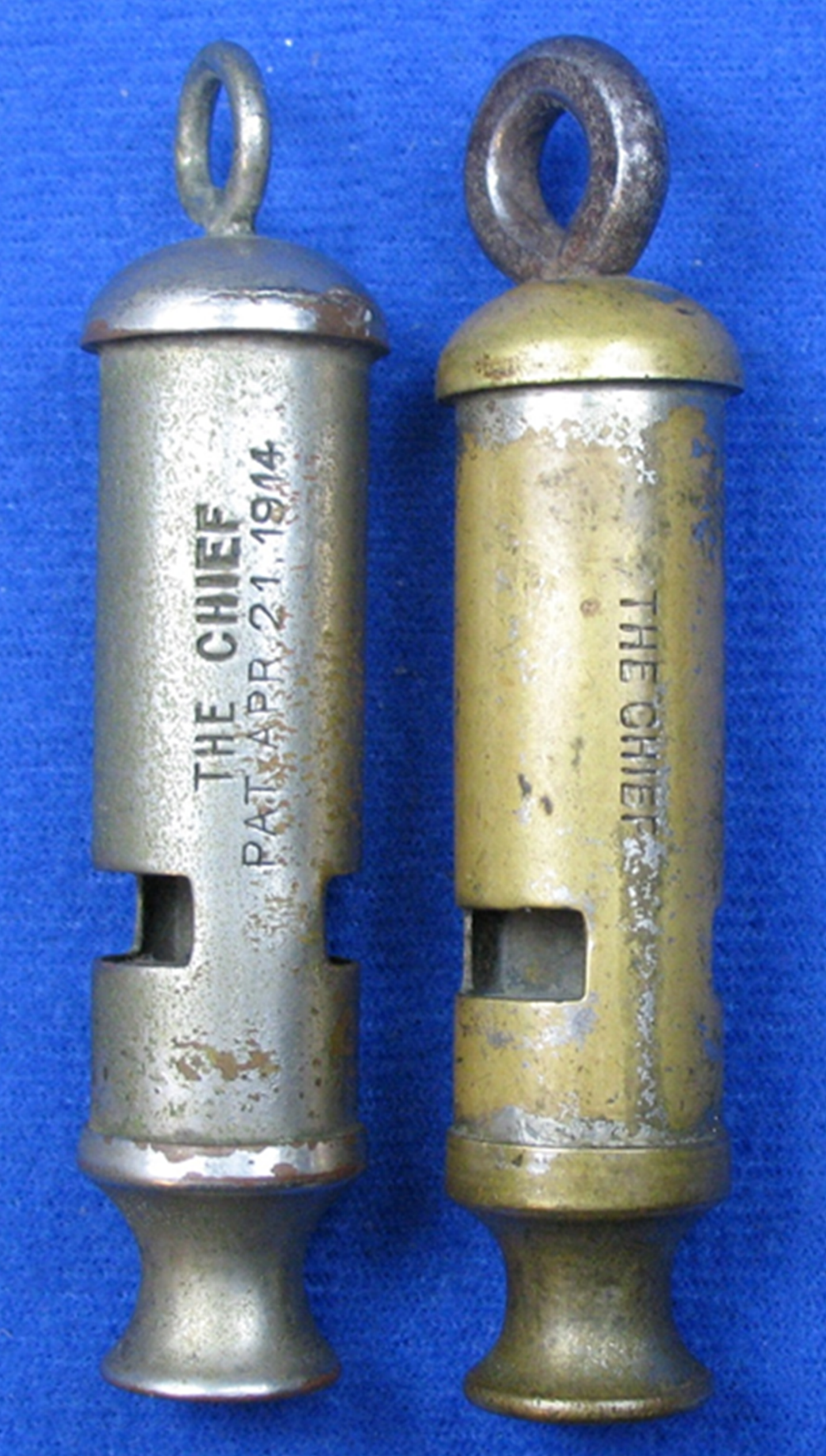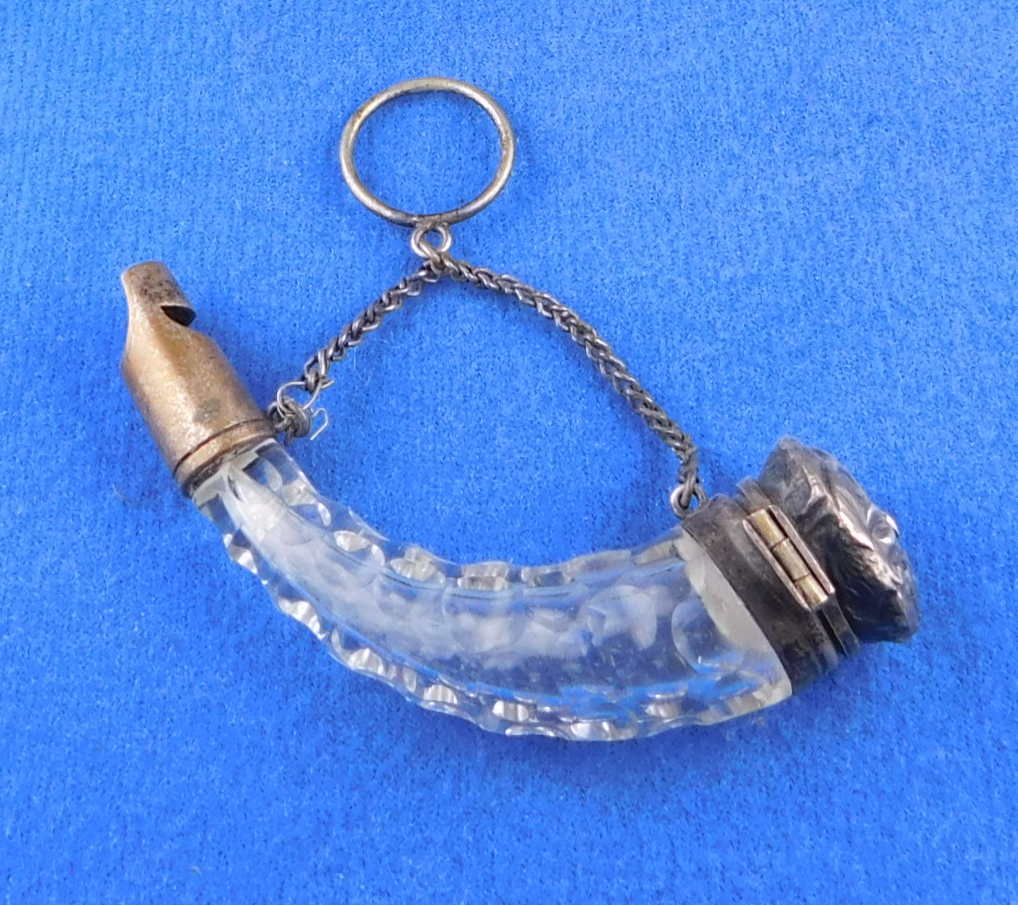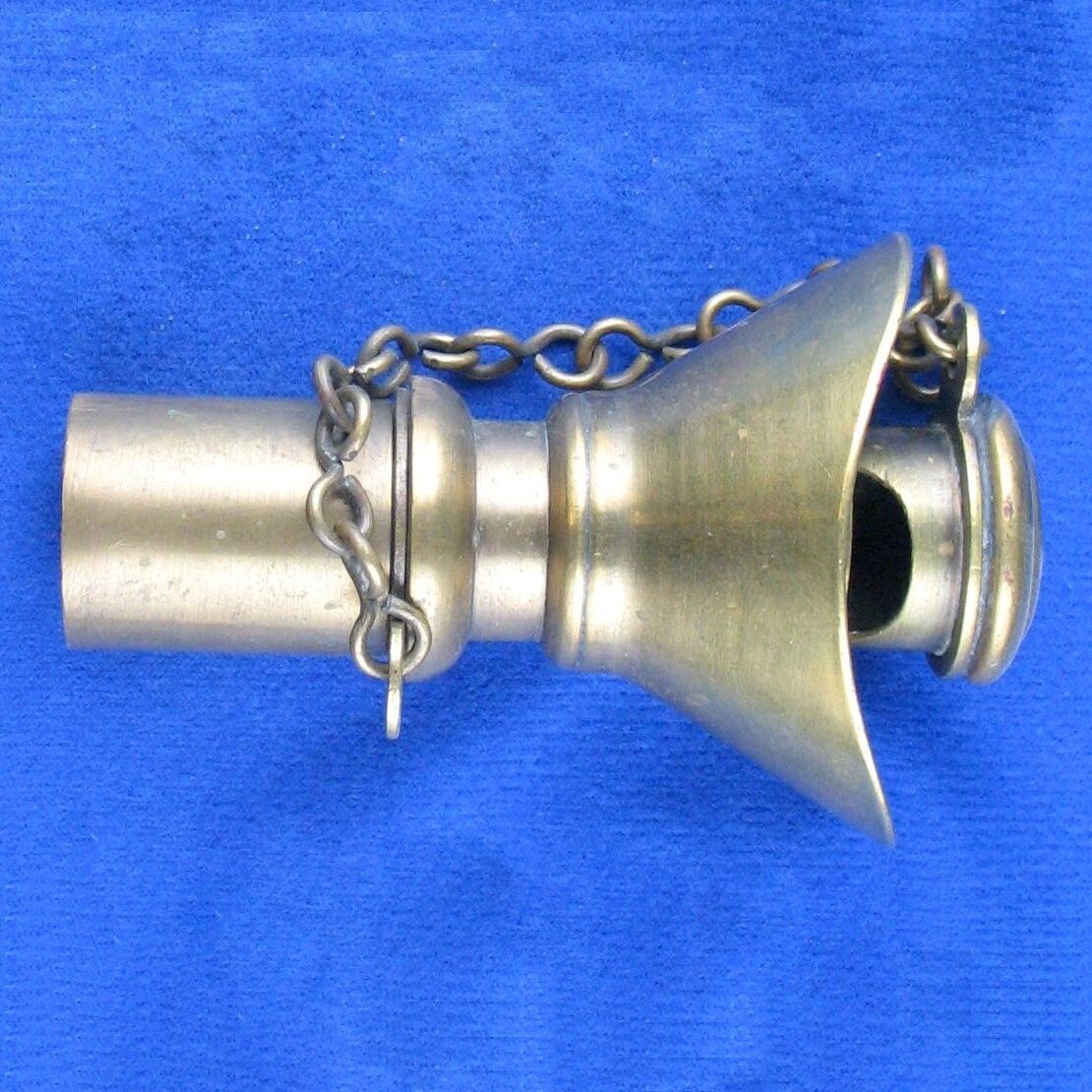Spotlight > Whistle Categories > Fire Brigade > 108
WHISTORY
Fire brigade whistles have a nebulous history. To start with their entry into the field of fire brigades is not recorded. Suffice it to say, that firefighting itself dates back to early Egyptian times. Early Roman history shows organization for fire damage control and then moving onwards in time to the UK and USA history – French, German, Dutch etc. will start us off. Studying the complete world history of firefighting is too extensive for our purposes, but does open the door to the relationship of whistles used for such purposes.
(SEE Wikipedia ‘ List of fire departments’ for more extensive research.)
This being said we form a framework or outline of fire brigade history, our goal, to review whistles in the process. It would appear that modern European brigades started re-forming in the 1800s for commercial reasons primarily, being motivated by insurance companies in the UK and apparently preceding insurance companies in the USA. Life/safety and property came hand in hand and as brigades became more organized they were taken over by municipalities and government. Public records from around the world are scattered on the World Wide Web, yet even more obscure are fire brigade whistle records and categorization of them. Here are just a few selections of brigade history:
For the UK:
‘After The Great Fire ( UK ), the first fire insurance company called “The Fire Office” was established in 1667 by Nicholas Barbon. His Fire Brigade employed small teams of Thames watermen as firefighters. Other similar companies soon followed his lead and this was how property was protected until the early 1800s. Policy holders were given a badge, or fire mark, to affix to their building. If a fire started, the Fire Brigade was called. They looked for the fire mark and, provided it was the right one, the fire would be dealt with. Often the buildings were left to burn until the right fire company attended. The Hand in Hand Fire Insurance Company was later to supersede ‘The Fire Office’ Company. – Fire Fighters Foundation
For the USA:
The United States did not have government run fire departments until around the time of the American Civil War. Prior to this time, private fire brigades competed with each another to be the first to attend a fire because insurance companies paid brigades to save buildings. Underwriters also employed their own Salvage Corporations who repaired the fire damage.’ – Fire Fighter Foundation
For Edinburgh:
—‘ James Braidwood had previously been the fire chief in Edinburgh, where the world’s first municipal fire service was founded in 1824,
For The Netherlands:
— ‘Jan van der Heyden was also an engineer and inventor who made significant contributions to contemporary firefighting technology. He improved the fire hose in 1672, with his brother Nicolas, who was a hydraulic engineer.[2] He modified the manual fire engine, reorganized the volunteer fire brigade (1685) and wrote and illustrated the first firefighting manual (Brandspuiten-boek). A comprehensive street lighting scheme for Amsterdam, designed and implemented by van der Heyden, remained in operation from 1669 until 1840 …’ – Wikipedia
For France:
— ‘Napoleon Bonaparte, drawing from the century-old experience of the gardes-pompes, is generally attributed as creating the first “professional” firefighters, known as Sapeurs-Pompiers (“Sappers-Firefighters”), from the French Army. Created under the Commandant of Engineers in 1810, the company was organized after a fire at the ballroom in the Austrian Embassy in Paris which injured several dignitaries.’
For Hong Kong:
— ‘The history of the Hong Kong Fire Services began with
the following announcement in the Hong Kong Government Gazette dated 9th May
1868: It shall be lawful for the Governor to
select from the Police and any others volunteering for the duty a force to whom
shall be entrusted the duty of extinguishing fire and protecting lives and
properties in case of fire within this colony and to furnish the said force
with such fire engines, hoses, accoutrements, tools and complements may be
necessary for complete equipment for the said force or conducive to the
efficient performance of their duties. The Force of Firemen established under
this ordinance shall be called the Hong Kong Fire Brigade and shall be under
the command of an officer to be called the Superintendent of the Hong Kong Fire
Brigade …”
WHISTLE ARCHAEOLOGY
The earliest whistles seen by internet studies are round whistles and button escargots. Stamped, issued whistles are rare. Button whistles made from brigade buttons are rare too, but can be found almost, but not quite as rare. As in police whistles, an unstamped whistle could have been used by a brigade member, but this discussion of fire brigade whistles is focused on identified stampings or designs such as cross axes—something that clearly associates the whistle with a brigade by itself.
Particularly sought after are named fire brigades, stamped from the manufacturer, then button ( escargot ) whistles fabricated using buttons from fire brigade uniforms and Glasgow type heavier escargots with heavy button like side walls or barrel ends. Next there were suppliers of fire brigade equipment who had whistles issued with their own particular company names stamped on them such as Shand Mason a major supplier of equipment. Many manufacturers issued whistles stamped for police or fire, but not identified with a particular brigade. At times special presentation whistles were engraved with fire brigades identified on them.
Why all the types ?? to quote one source, ‘ Between the 1860s and 1940s there were lots of different types of fire brigades. There were volunteers, parish council brigades, industrial, country-house, police-fire brigades and municipal and local authority brigades’. Each had their preference when using or issuing whistles.
So far we have seen 6 types:
1) beaufort
2) buttons
3) combinations
4) escargots
5) round whistles
6) tube shaped
All of which we are organizing into seven categories ( of course any type or unmarked whistle could be used by a fire department or an individual fireman ).
One of the more interesting questions that arise is… Why would some whistles be stamped police or fire?? There is evidence that fire departments and police departments were built in proximity or combined, thereby making it easier to use products available to both.
“Many of the smaller city police forces were combined with the fire brigades. My home city police were called Hull City Police Fire Brigade, some of the fire fighters had additional police powers.” — (Cited from: https://www.antiquers.com/threads/city-police-or-fire-whistle-c-t-w-s.8976/)
Indeed the early Roman forces, individuals called VIGILE ( from where we get vigilante ) not only worked to extinguish fires, but also patrolled the city for criminals. Police and fire dept’s housed together were called police fire stations. Until the 1938 Fire Prevention Act in the UK, police had been also responsible for fire-fighting. The 1947 Fire Service Act formally abolished police fire brigades.
In the UK, the LCC ( London County Council ) 1889 – 1965 deserves special attention for its early whistles ( The predecessor of 1855 — the Metropolitan Board of Works was appointed MBW ). The Council, upon its creation ( 1889 ) assumed the responsibility for the Metropolitan Fire Brigade from the Metropolitan Board of Works. August of 1904 changed the name to The London Fire Brigade. So we see whistles stamped for many years with LCC well into the 1930s from as early as 1883-4.
Another interesting fact that surfaced; Fire fighters were
recruited from Thames Watermen very early on. ( 1667 records small teams of
Watermen as fire brigades ). –‘After The Great
Fire, the first fire insurance company called the, “The Fire Office”, was
established in 1667 by Nicholas Barbon. His Fire Brigade employed small
teams of Thames watermen as firefighters.’
— ‘The first fire fighters were recruited from Free Watermen who
operated water taxis on the Thames. They made good part-time fire fighters
because they were self-employed, reliable and they were used to working hard in
difficult conditions. Many Watermen were ex-sailors.’
WHISTOLOGY
For study purposes we have divided up into 7 categories fire brigade whistles. There may be some that do not fall so easily into a group and they will be dealt with individually under ‘exceptions’. As fire brigade whistles are difficult to come by, coupled with being very expensive, we will uncharacteristically be posting pictures of whistles not in the reference collection. They will be identified as by permission or ‘unattributed’ and we would ask for permission or we will withdraw them as instructed by the original owners. – All blue background are copyrighted as owned by The Whistle Gallery.
Categories
Fire brigades – [ tubes, beaufort ]
BFB ( Birmingham Fire Brigade )
Crosswellshire?
Harborne
Kenilworth
LFB ( London Fire Brigade )
Manchester
Tangyes
Buttons
Darlington
Suppliers – [ rounds, tubes, beauforts, combinations ]
Dolan and Sons ( renewed clothing contract June, 1904 )London
Merryweather and Sons (from 1869, prior S M in 1928 Greenwich London)
Morris and Sons
Reynolds and Co. [ wharfingers, harbormasters ] ??
Rose and Company ( 1884 adv. ) Manchester
Shand Mason and Company
Police or Fire – [ tubes, beauforts ]
B&R
DeCourcy
Hudson
Lilly
Ward
Yates
The Chief – tubes
Gotham
LCC – tubes Hudson
Engraved – escargots,beauforts, tubes
Hudson – tube
unknown – escargot
unknown – silver beaufort
Waterman –
Provenance –
Stamped Fire Brigade
…with the actual named Fire Brigade stamped are rare. Whether this is due to rarely being issued or perhaps because they are rarely released is unknown. Although police whistles can be quite common, the same is not found with named brigades. The following picture captures a brigade name – Harborne ( Birmingham ) for example.
This is the only King whistle by Hudson with a Fire Brigade stamp known, circa 1883-4. Apparently in a private collection as the photo was sent second hand from another collector. – four inches long.
Circa 1883-4, a very early whistle, from 84 Buck Street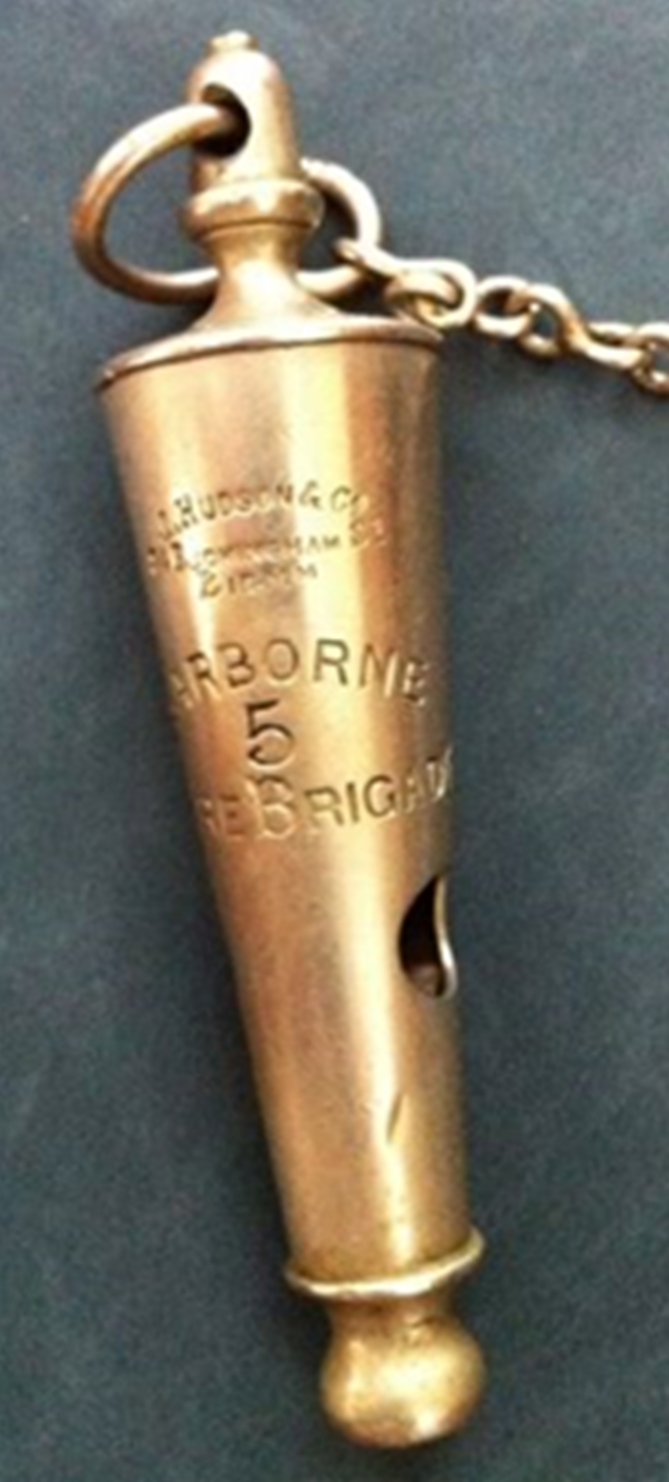
(photo credit needed)
More often than not a tube shaped whistle typical of Hudson Metropolitans carries a brigade name such as this Crosswell (shire? ) 4 — dated 1885-89 – credit needed for pic.
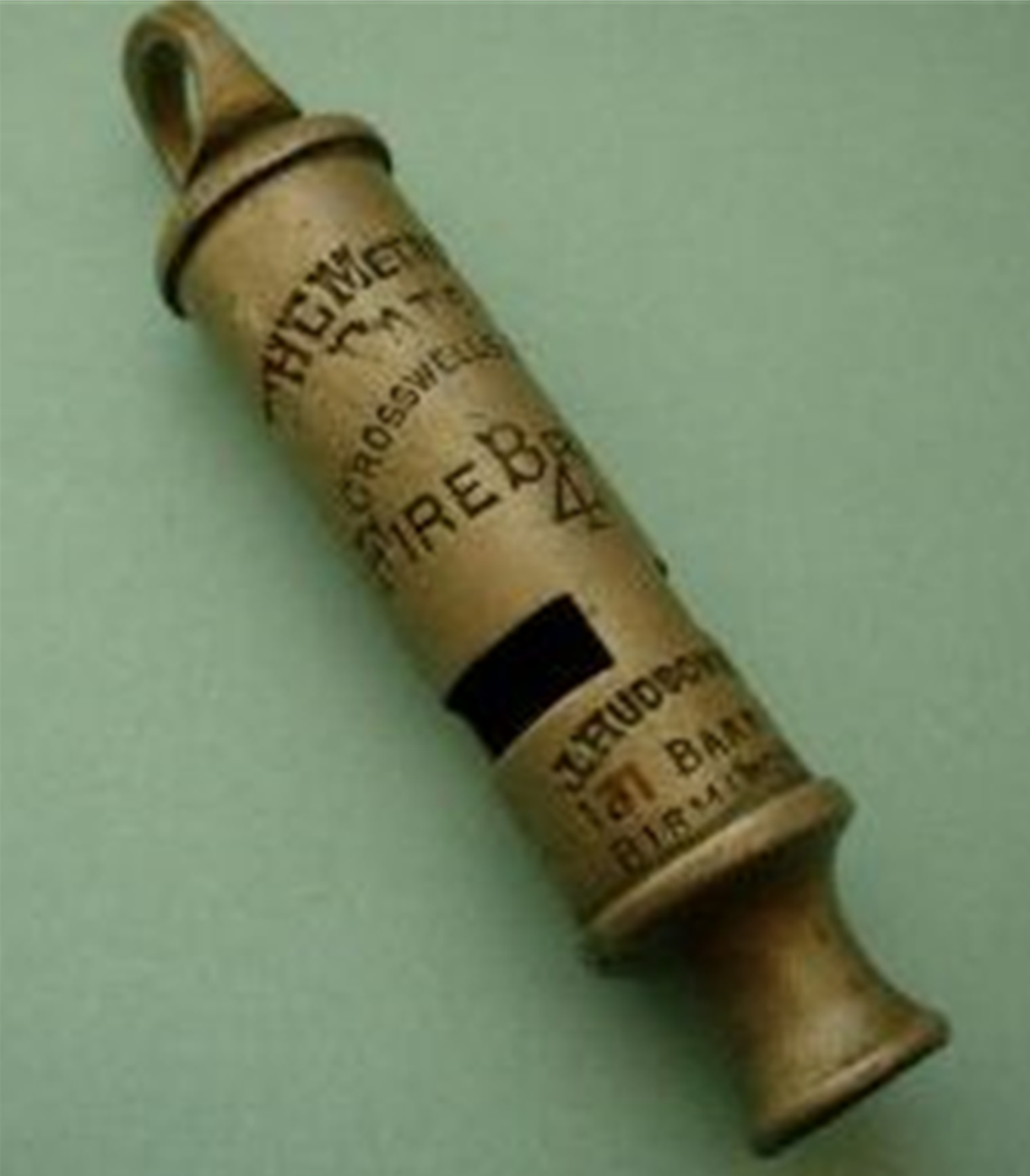
Here ( by permission ) is a very early DeCourcy Shand Mason stamp
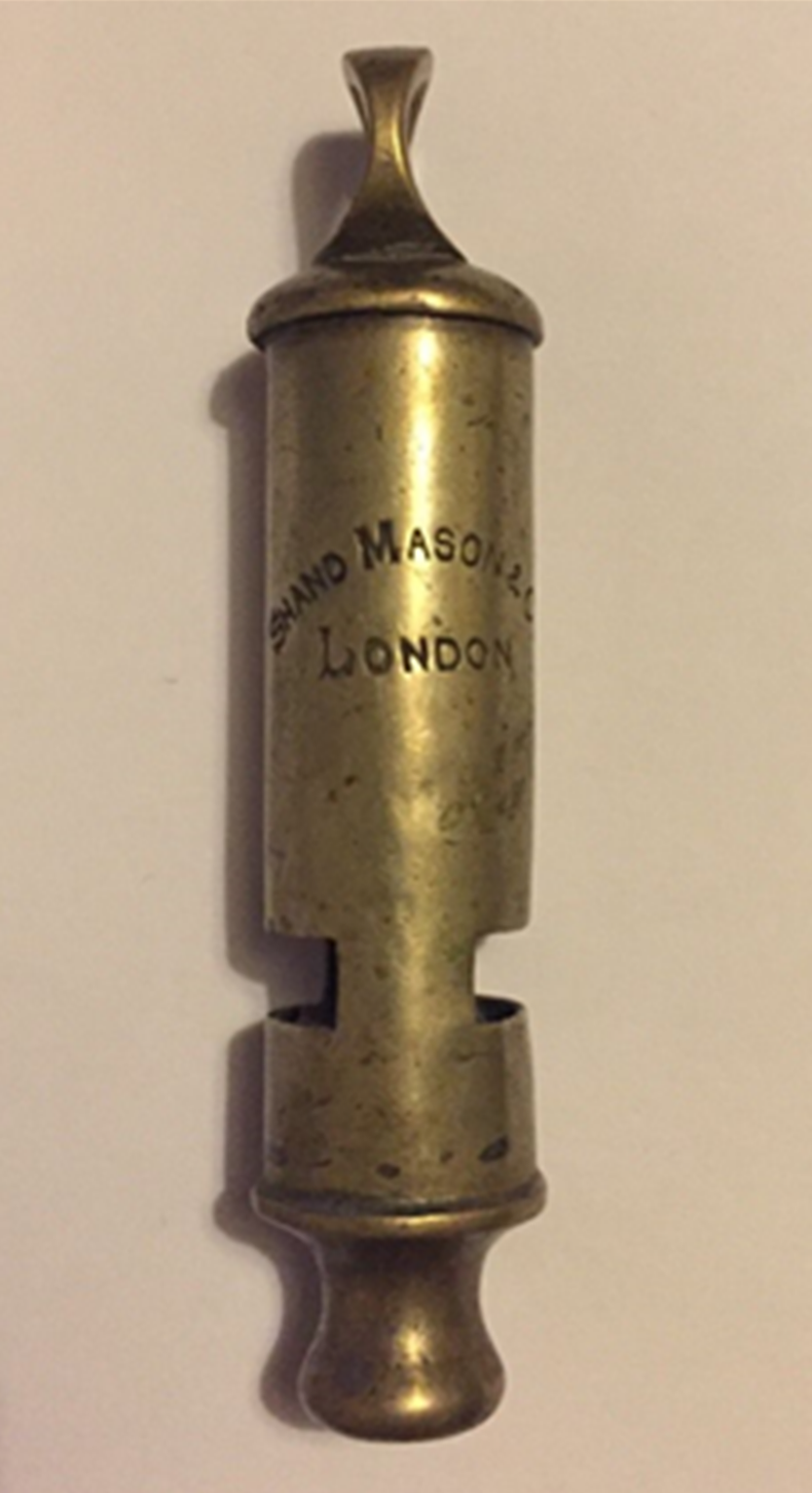
This Kenilworth sold for over 700 dollars on auction.
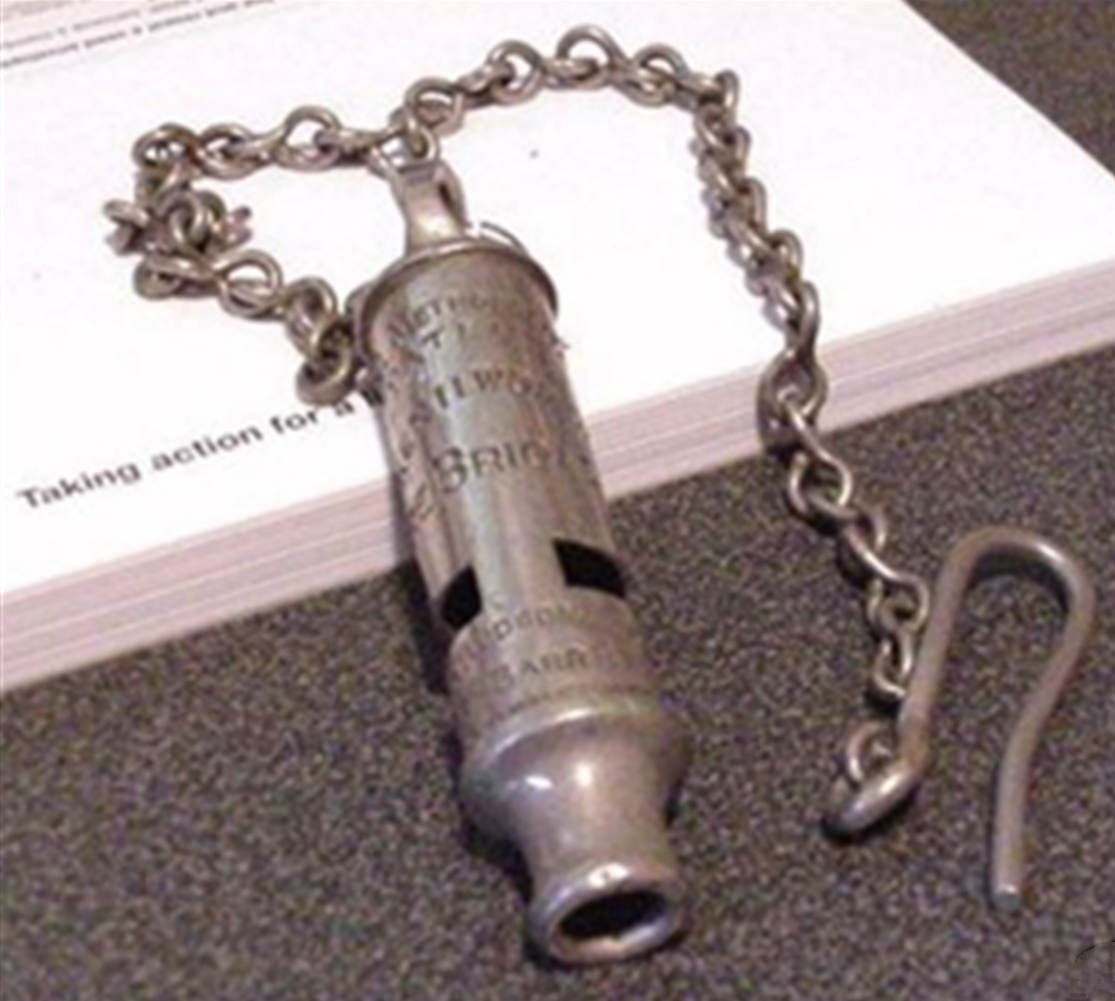
( credit needed )
Chris Mattison granted permission for the next picture of this fine Manchester Fire Brigade circa 1883-4 by Dowler & sons with a cast mouthpiece and top.
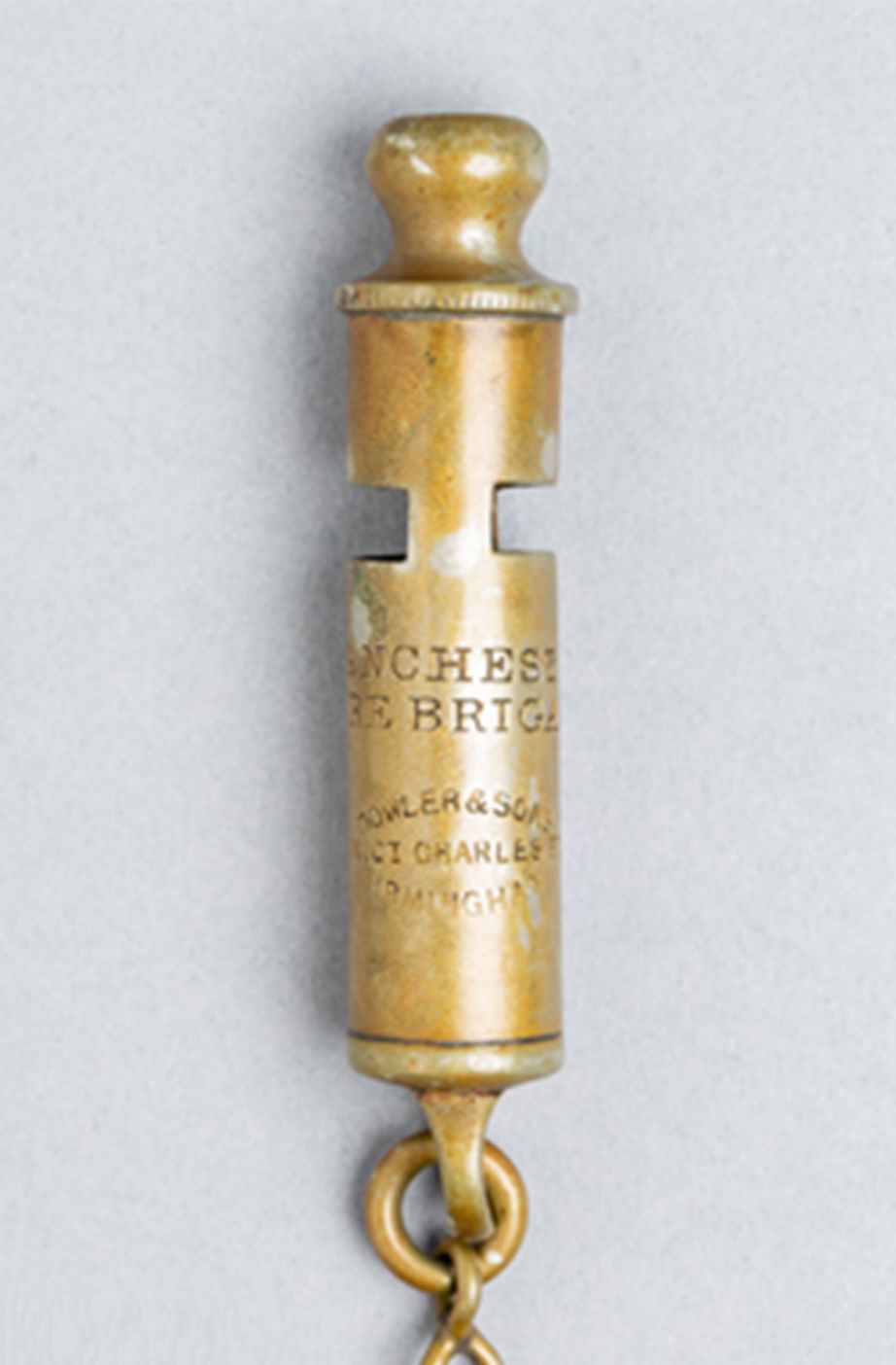
Fire brigade stamps are stamped occasionally with simply the letters, for example this acronym – BFB ( Birmingham Fire Brigade )
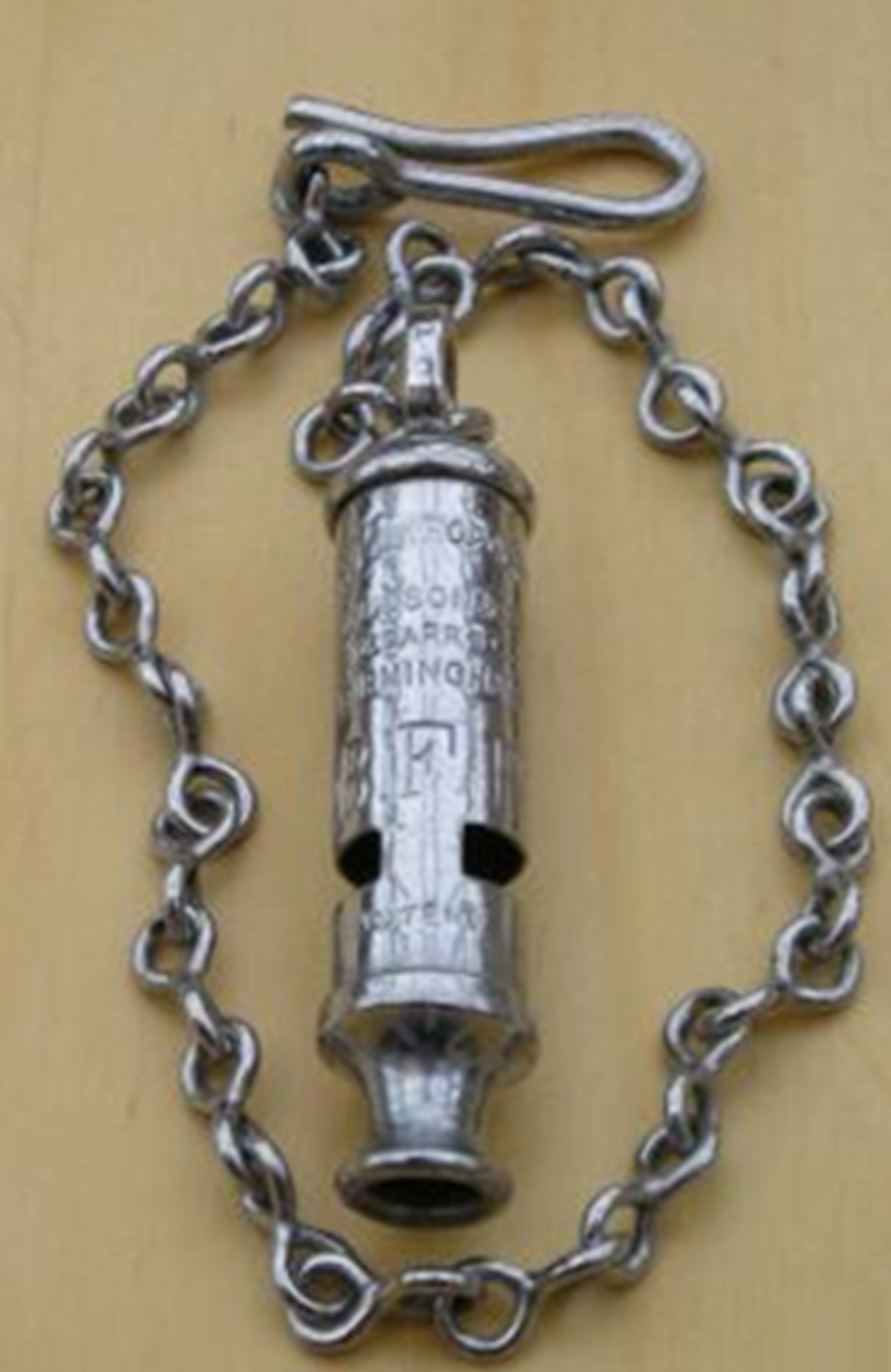
( credit needed )
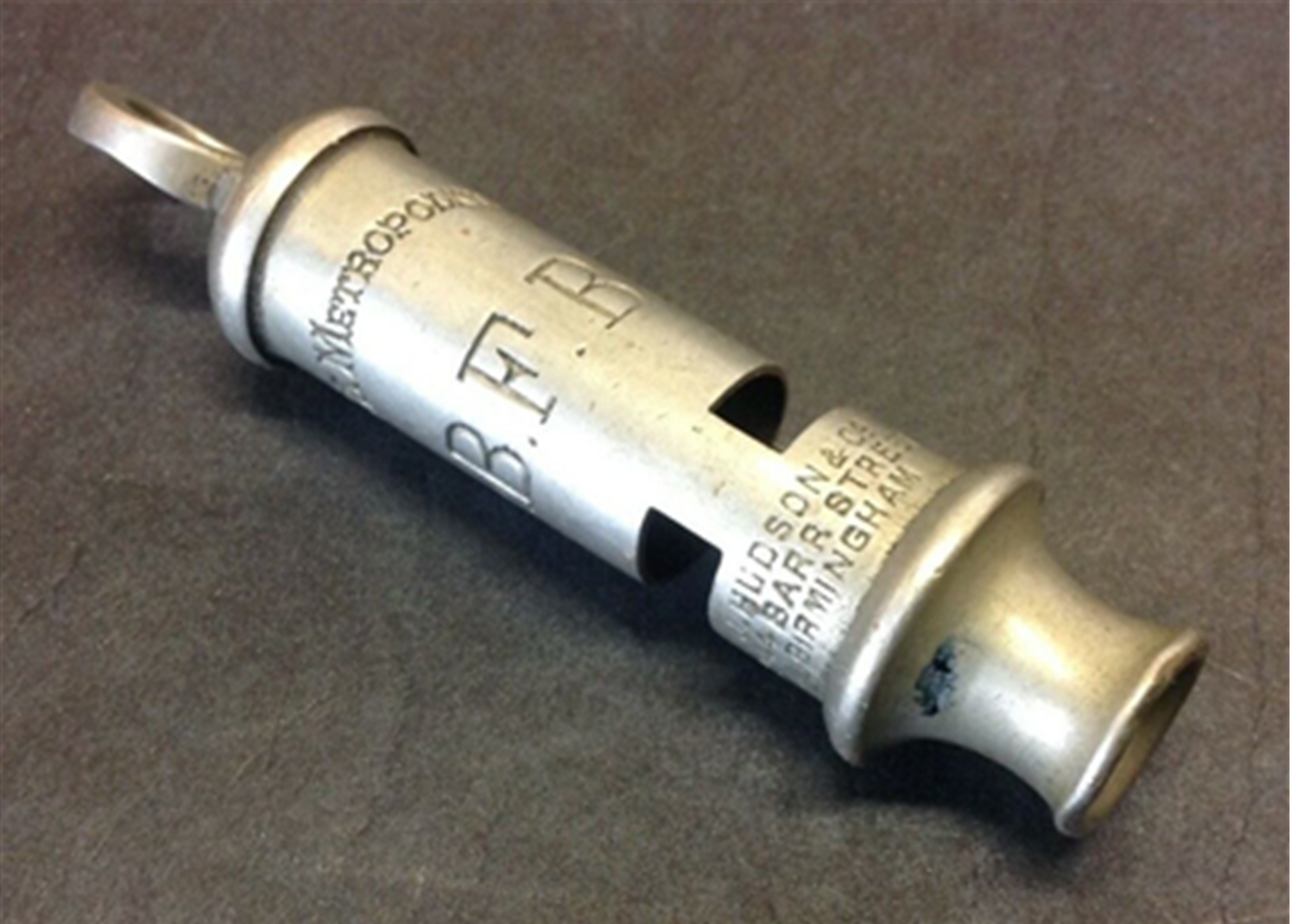
( courtesy of ‘thead21’ )
Tangyes Fire Brigade C. 1888 to 1908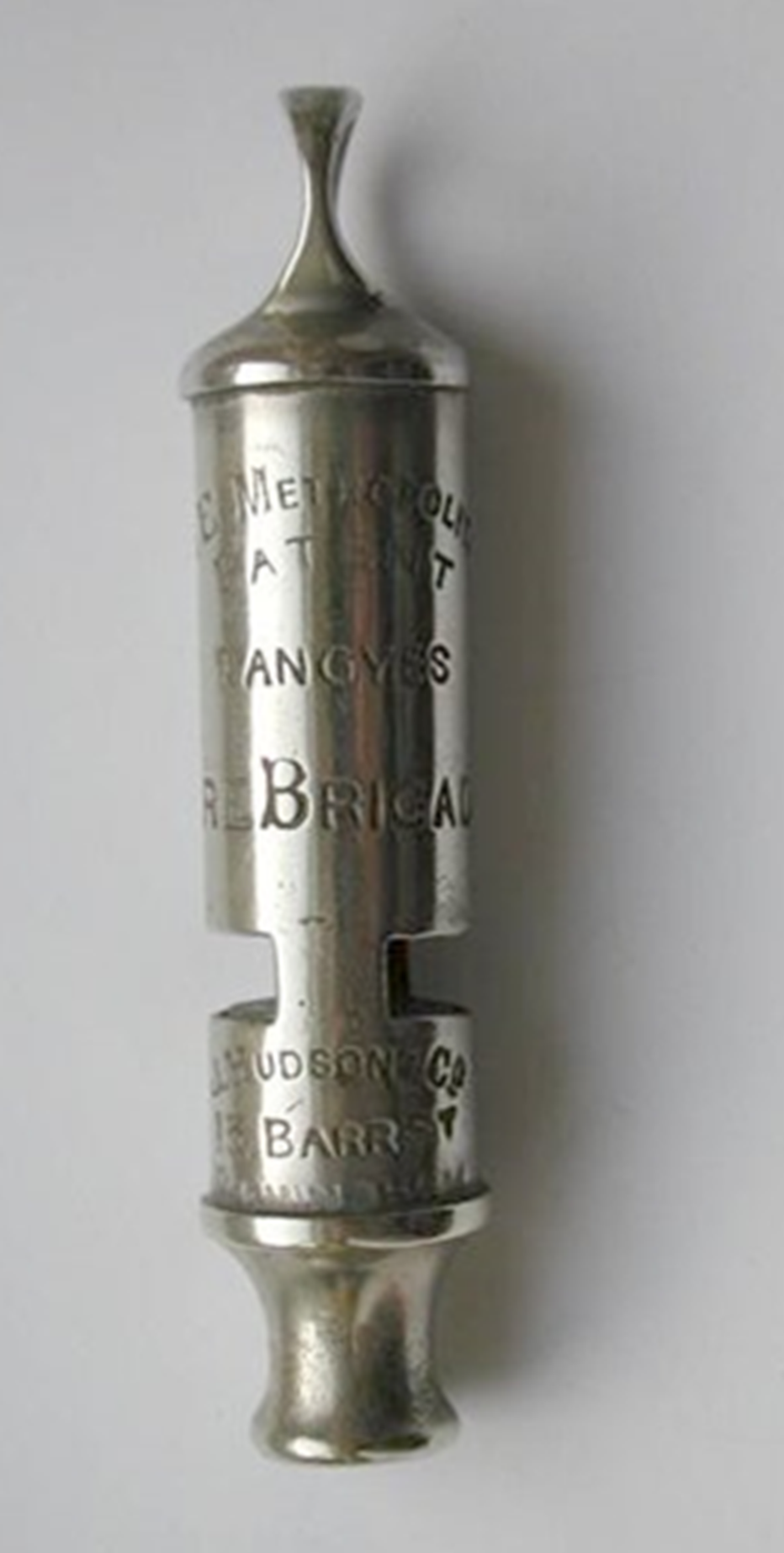
(Photo courtesy of Leif Bailey)
Button Whistles
Typical, but not held to, are cross axes used for fire brigade symbols on the uniform buttons which helps to identify fire brigades, but not which one.( or seated horse ? ) [pix by permission]
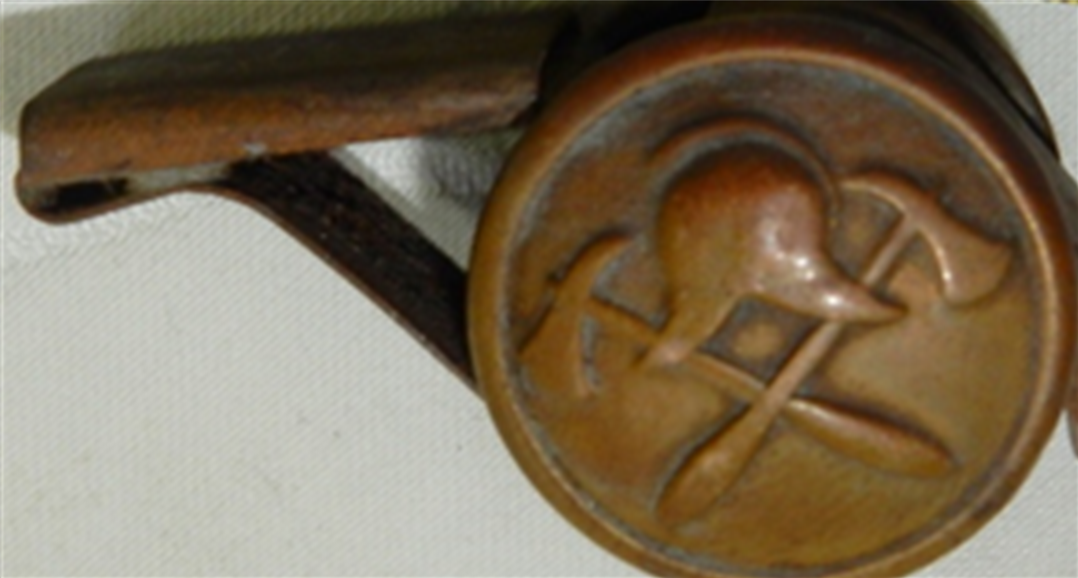
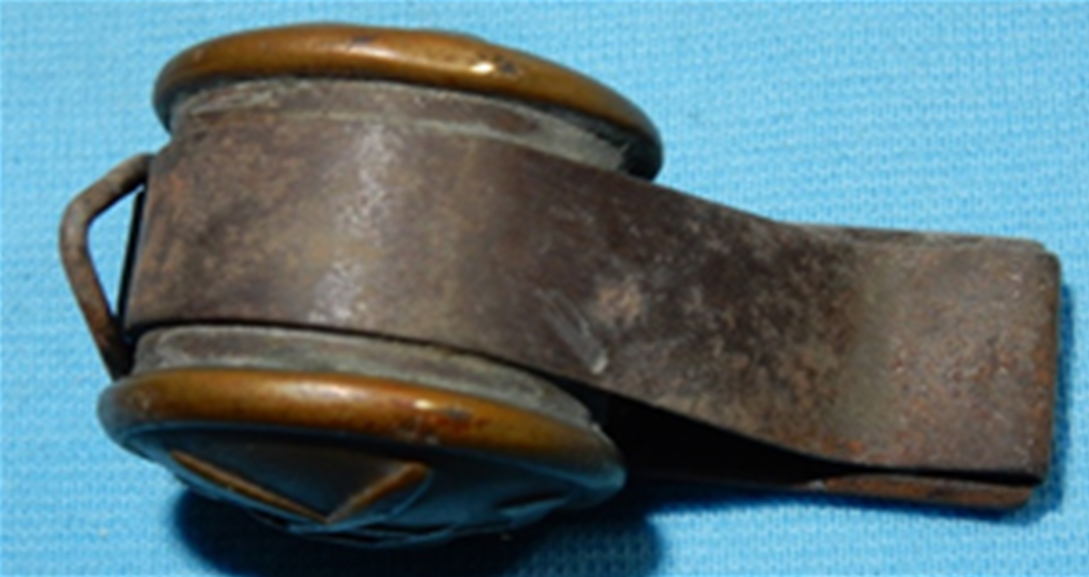
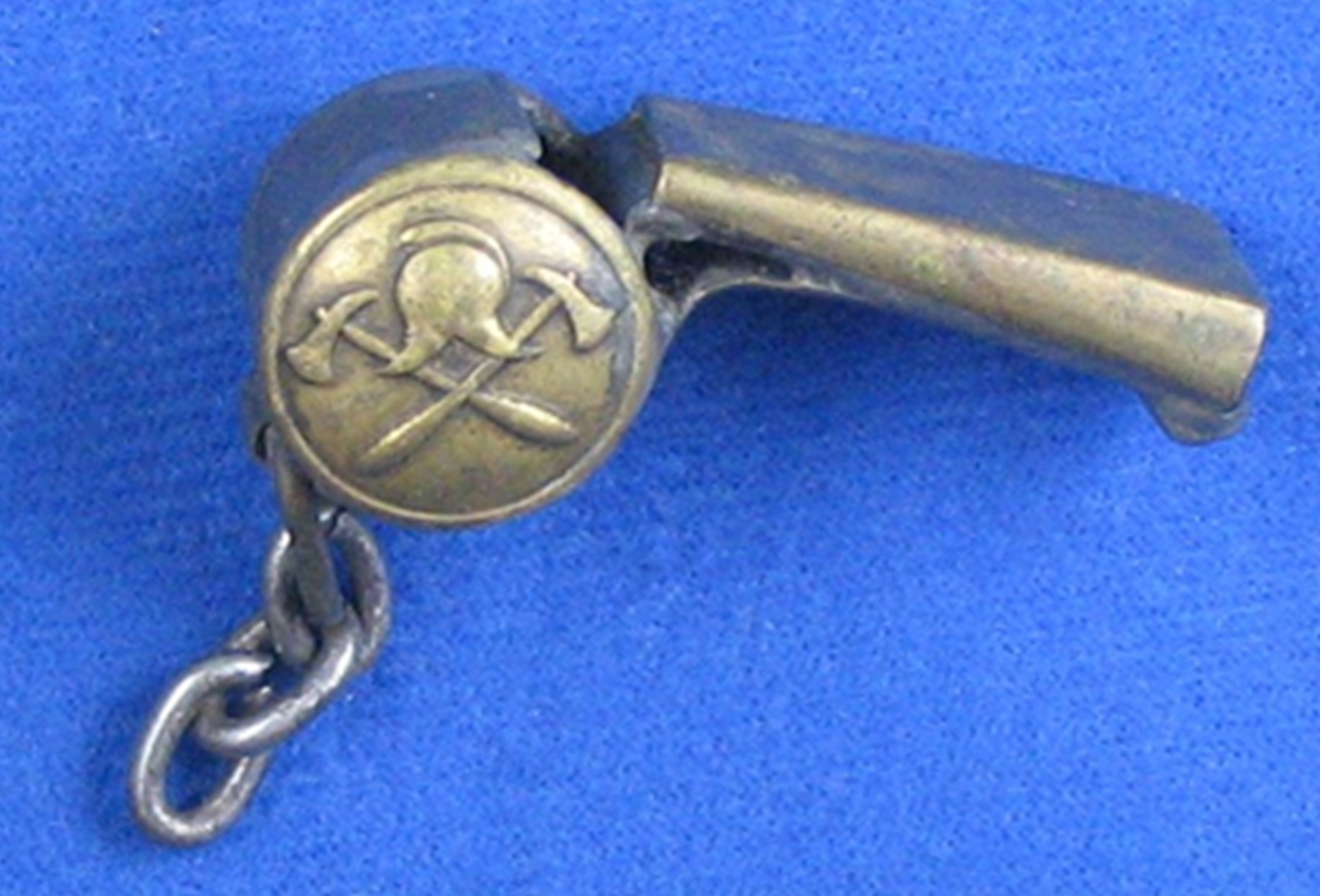
From the Whistle Gallery reference collection
Circa 1867 Darlington Fire Brigade corp.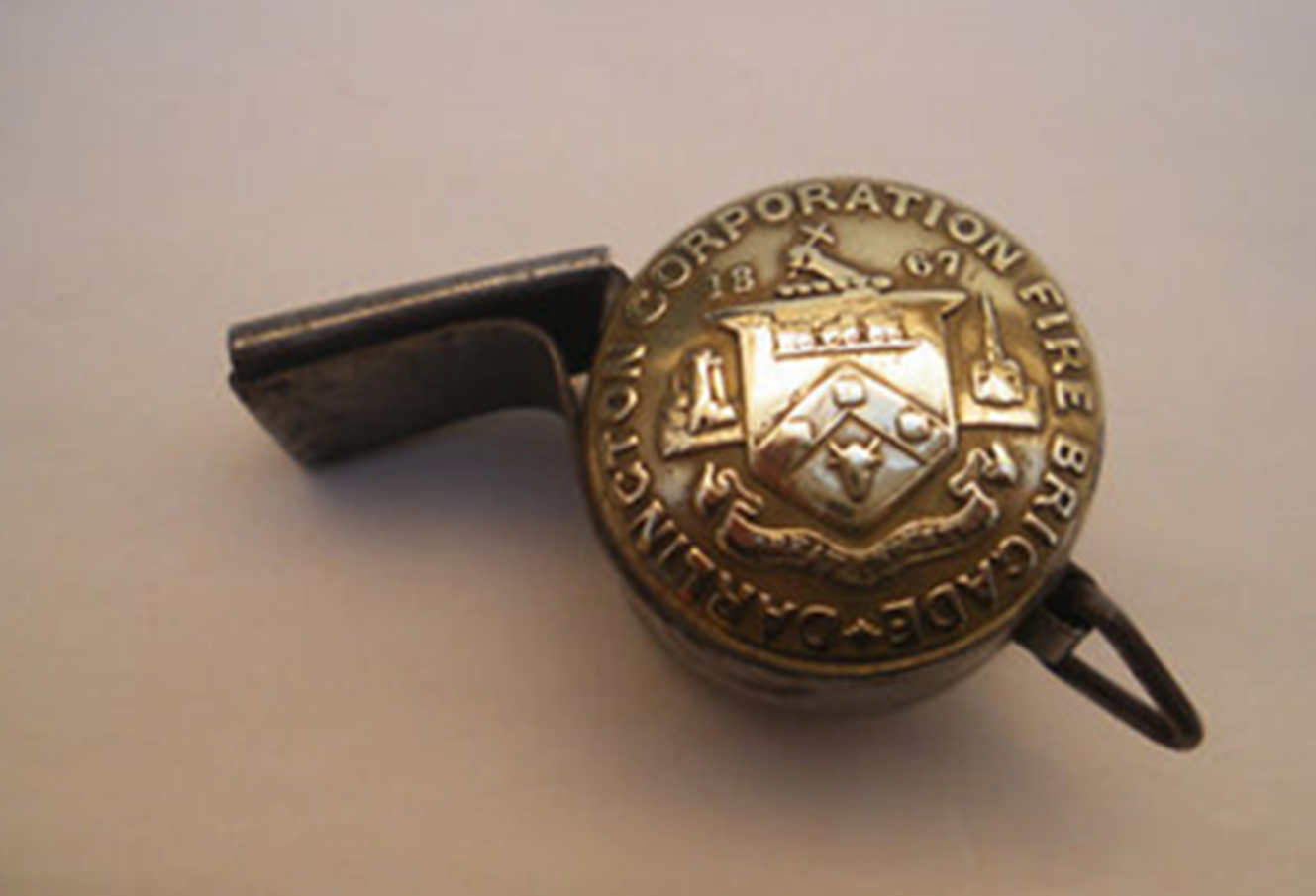
(credit needed)
Seated horse ?? (Whistle claimed to be stamped as D. Dowler )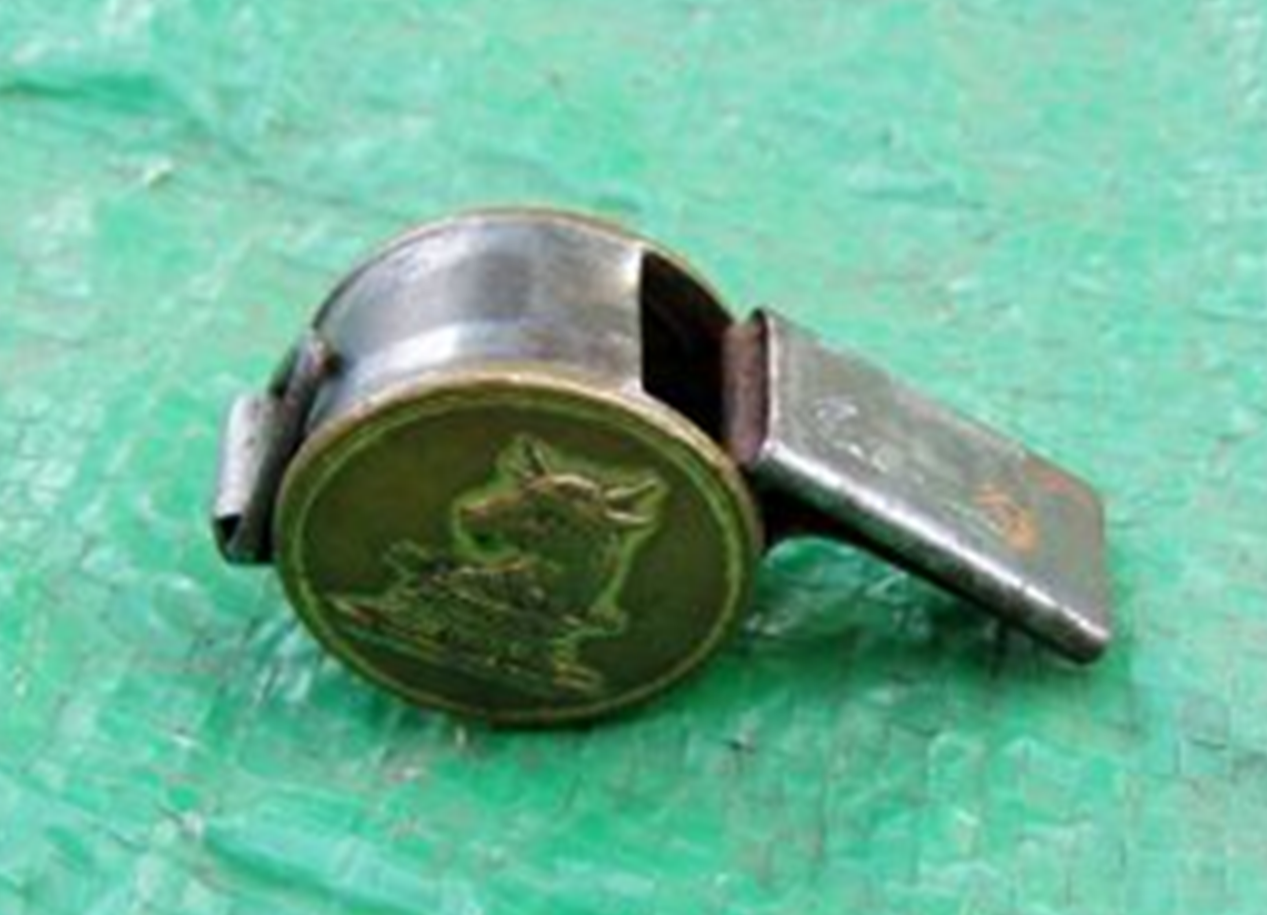
(Credit needed)
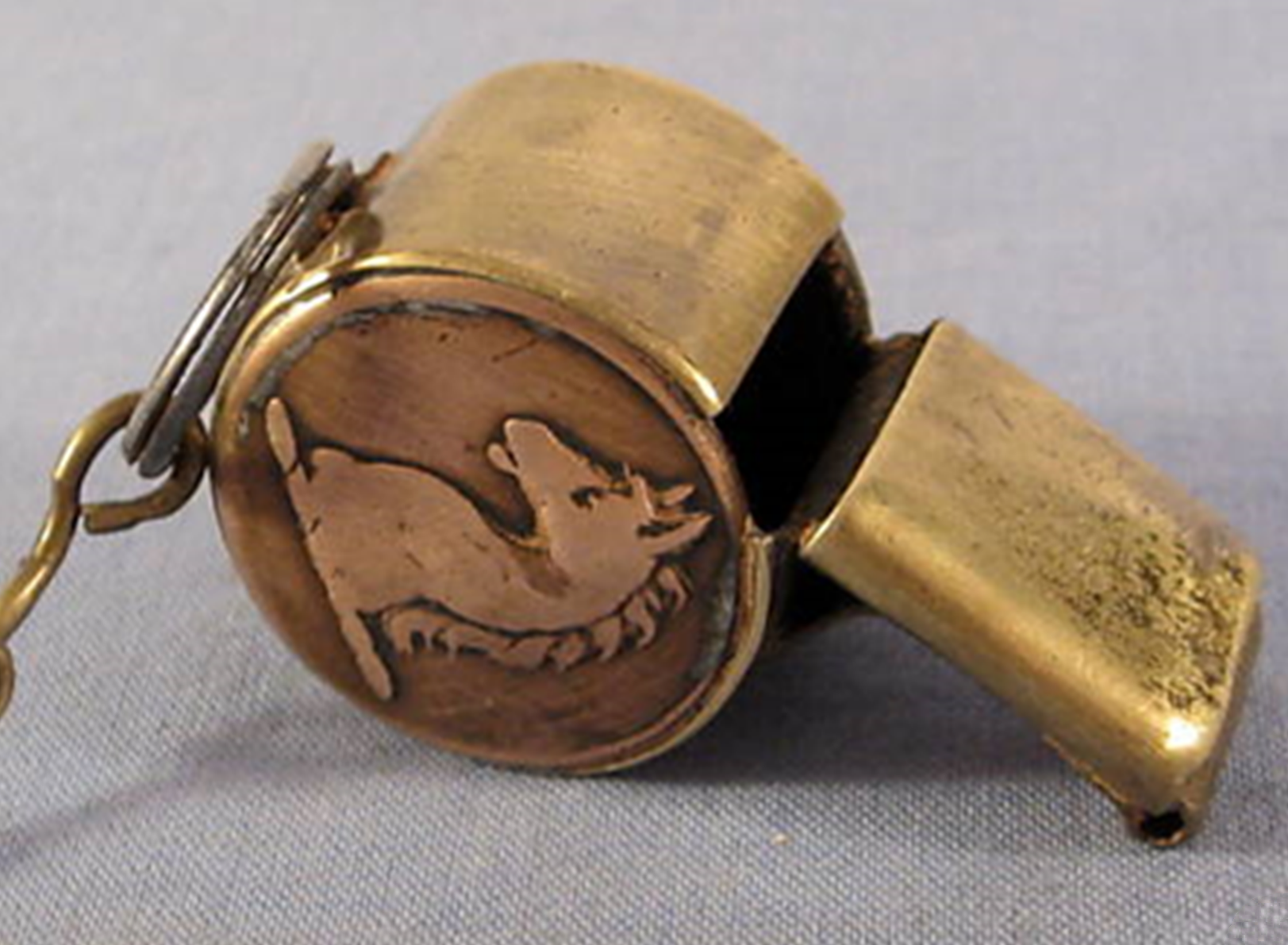
(credit needed)
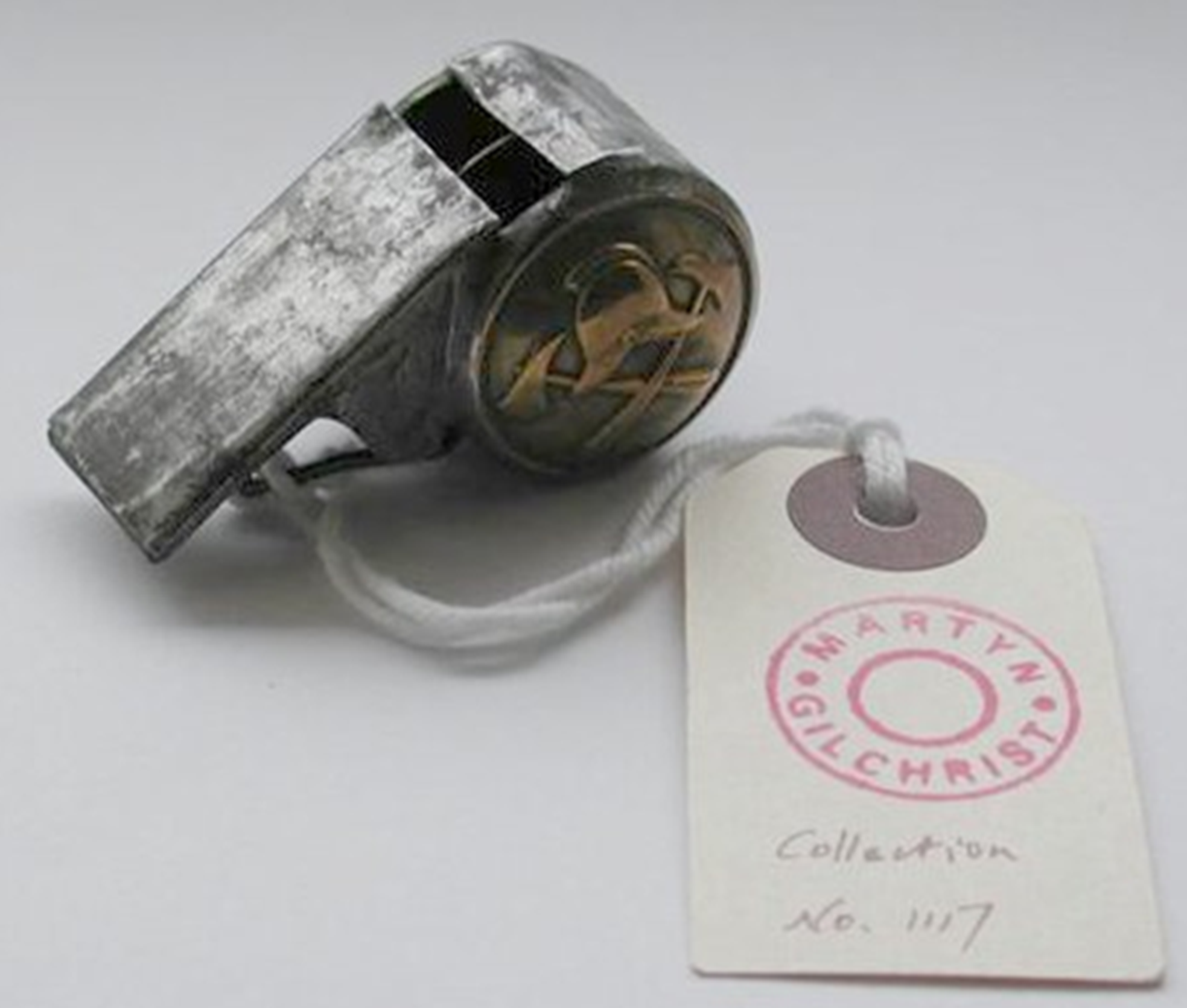
(Photo courtesy Leif Bailey)
Buttons from brigade wear.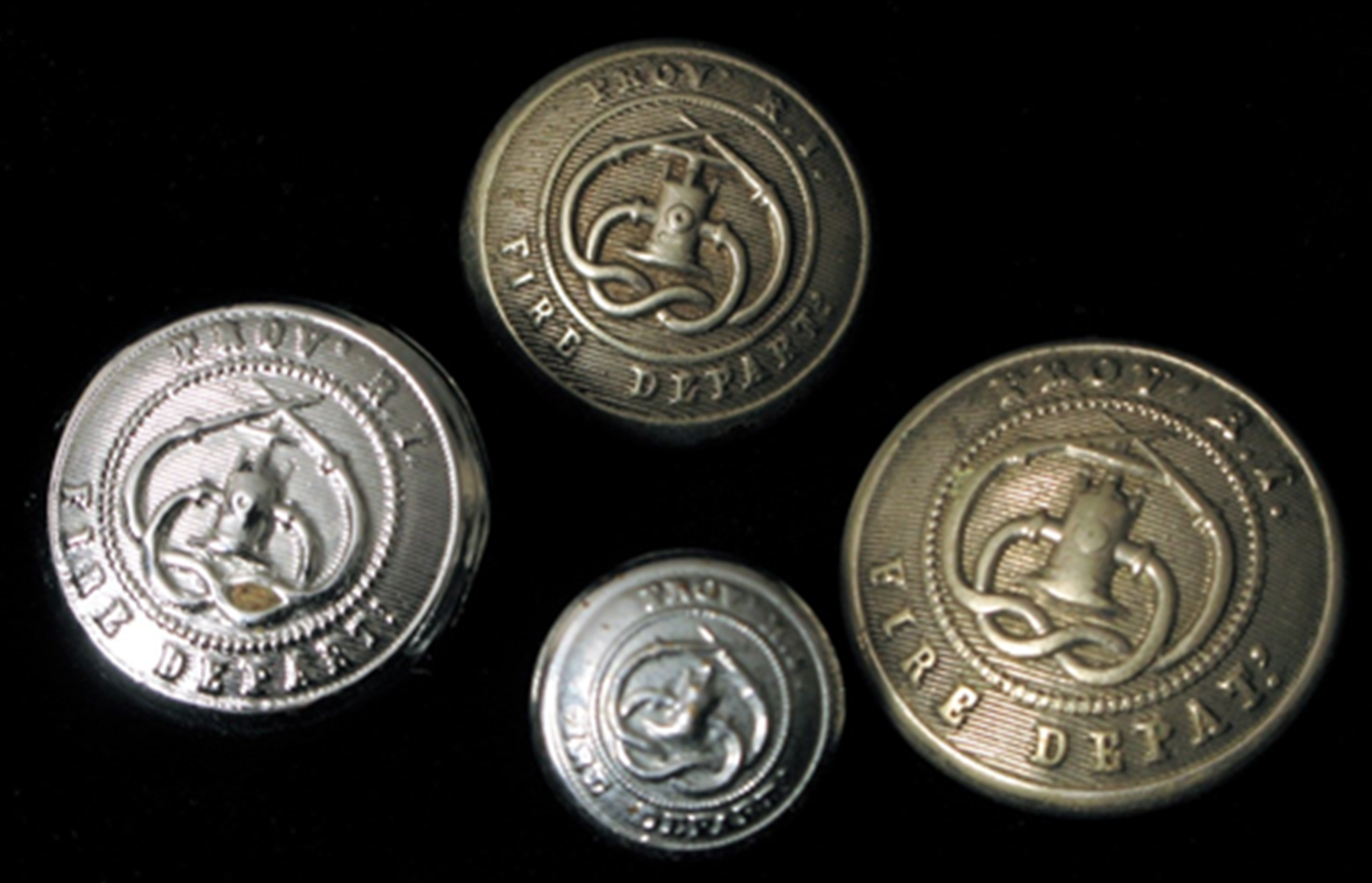
( uncredited )
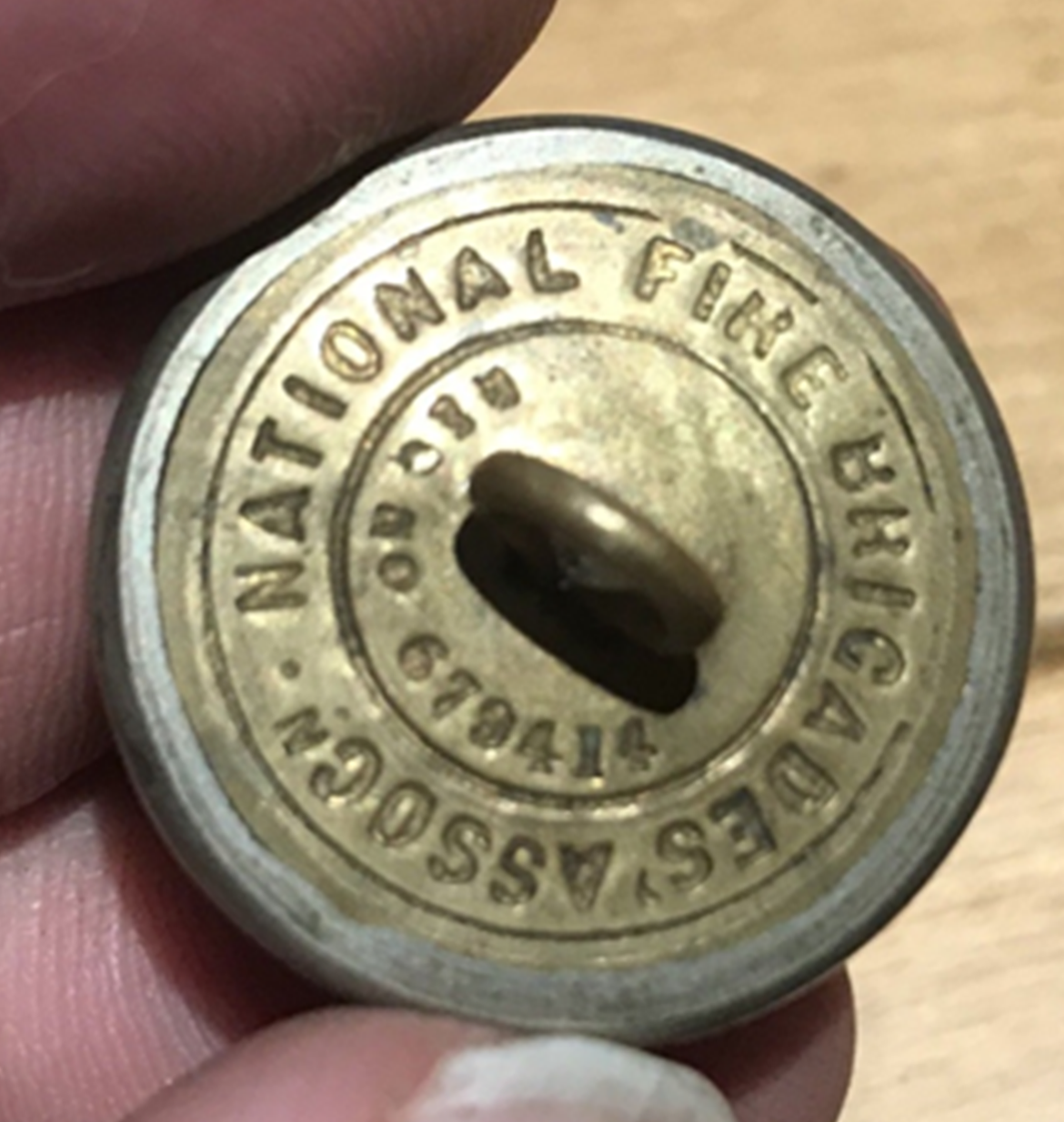
( uncredited )
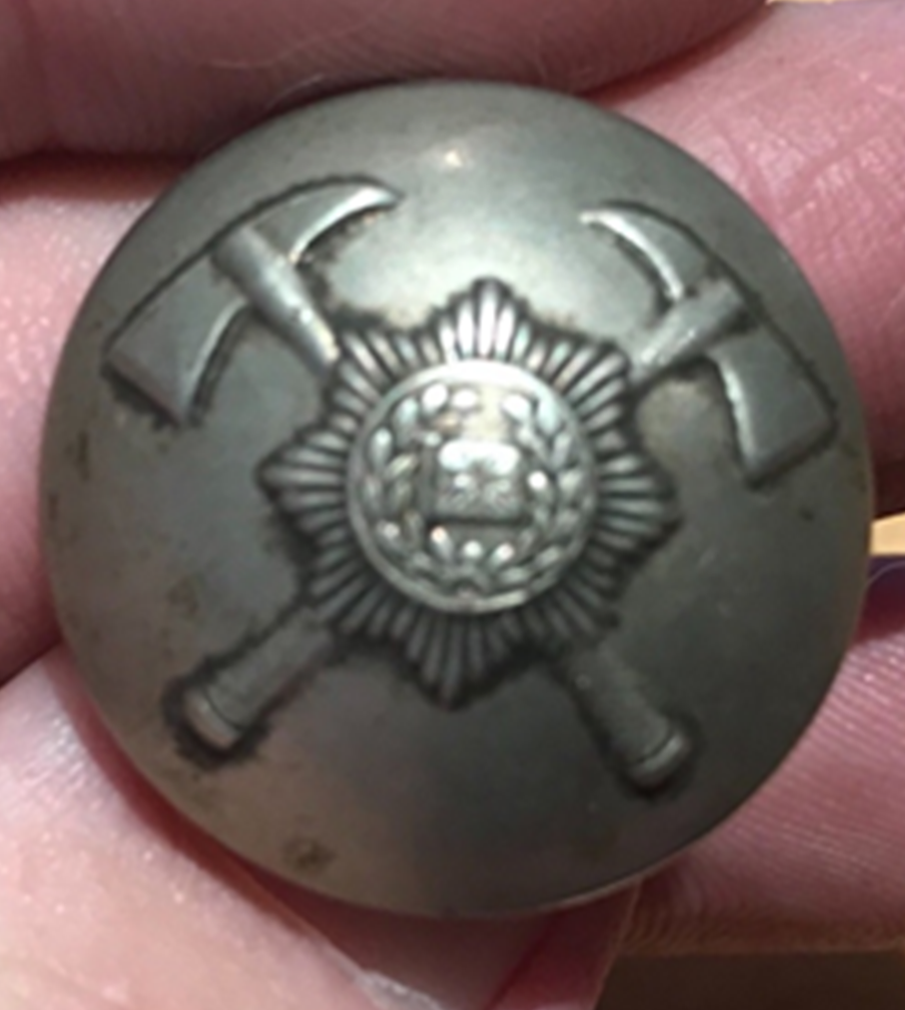
(credit needed)
Suppliers Stamps
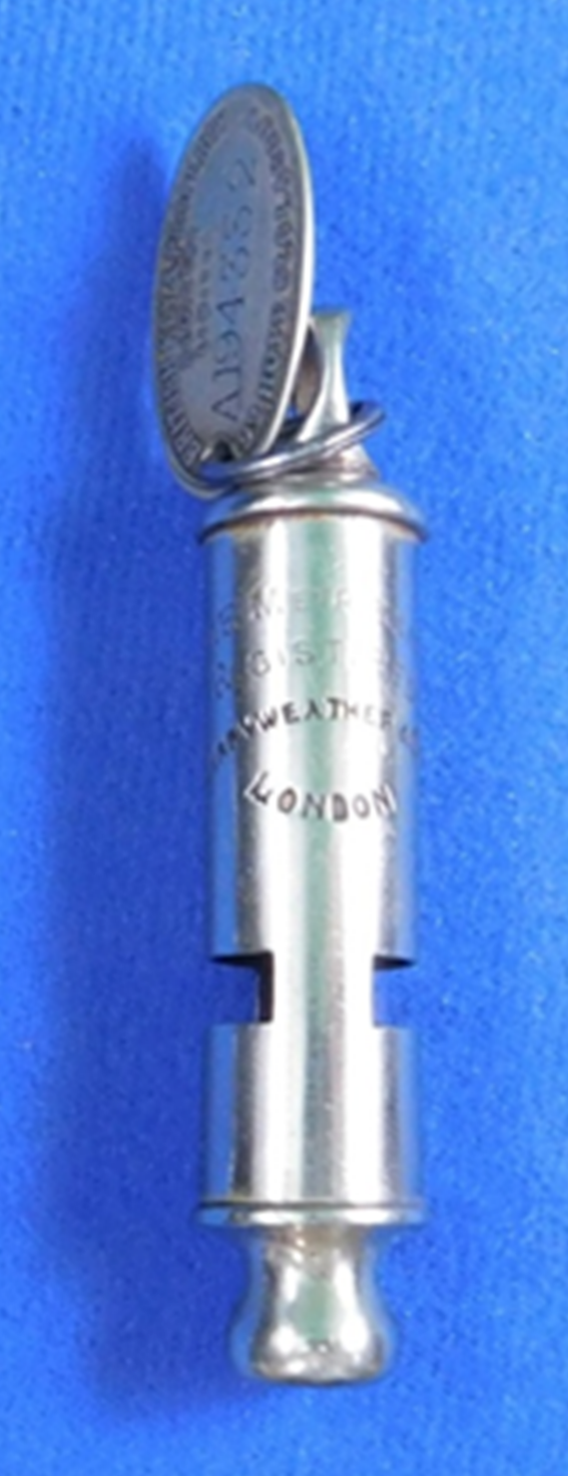
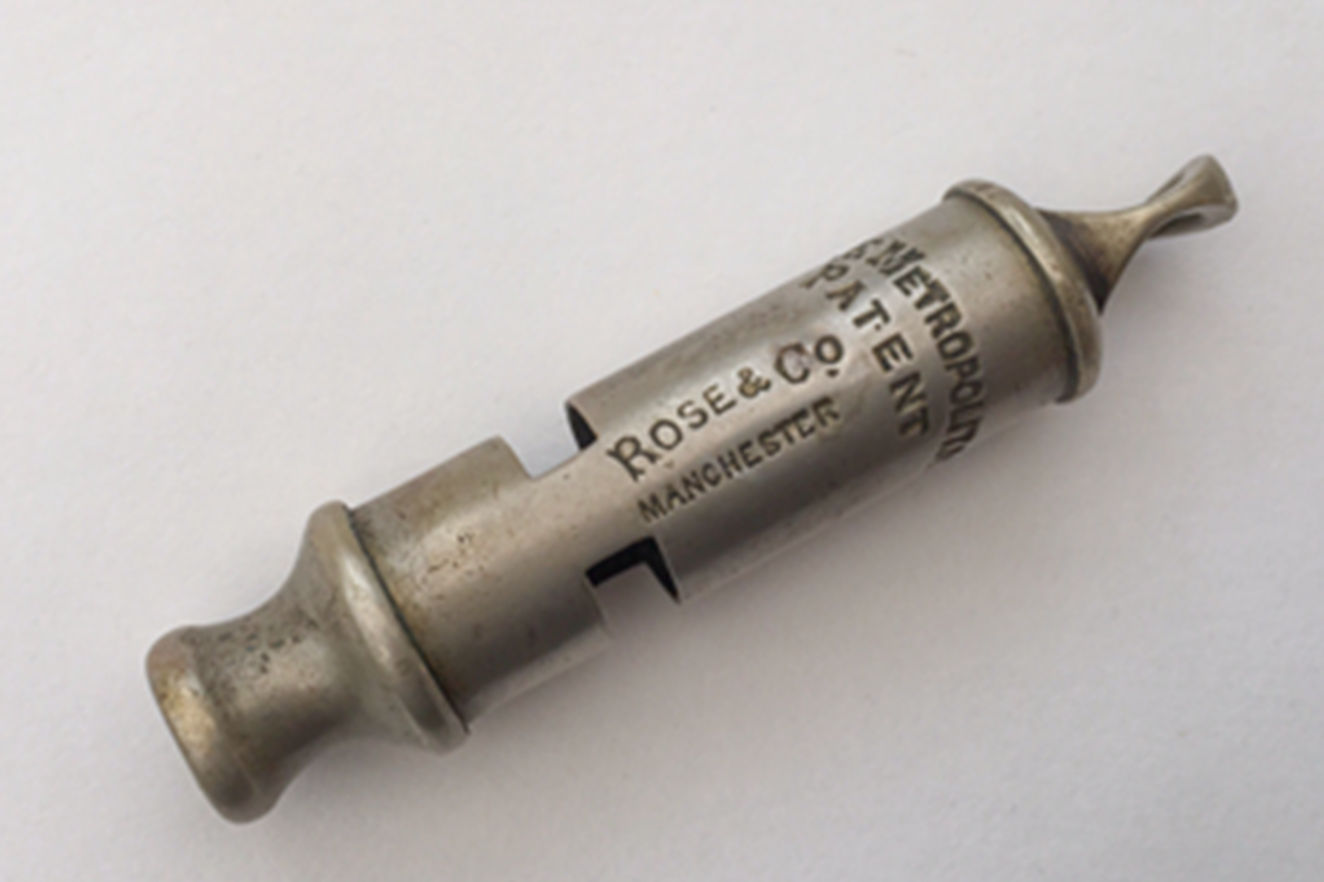
( Courtesy Pete Owen )
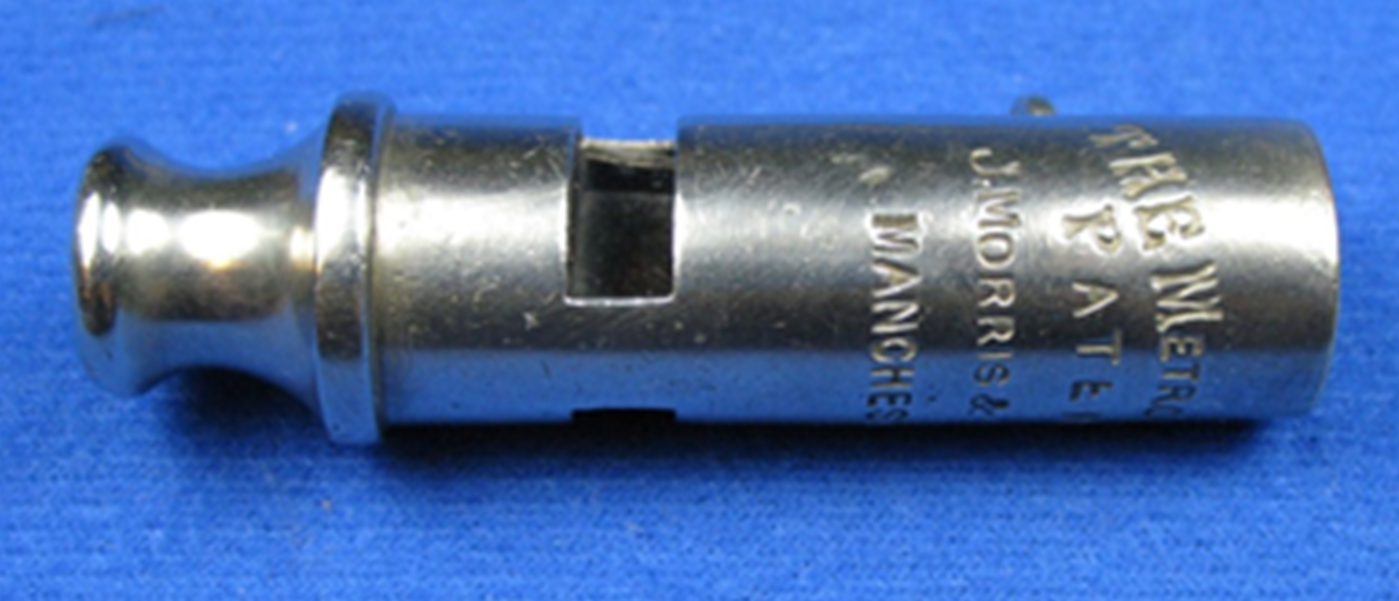
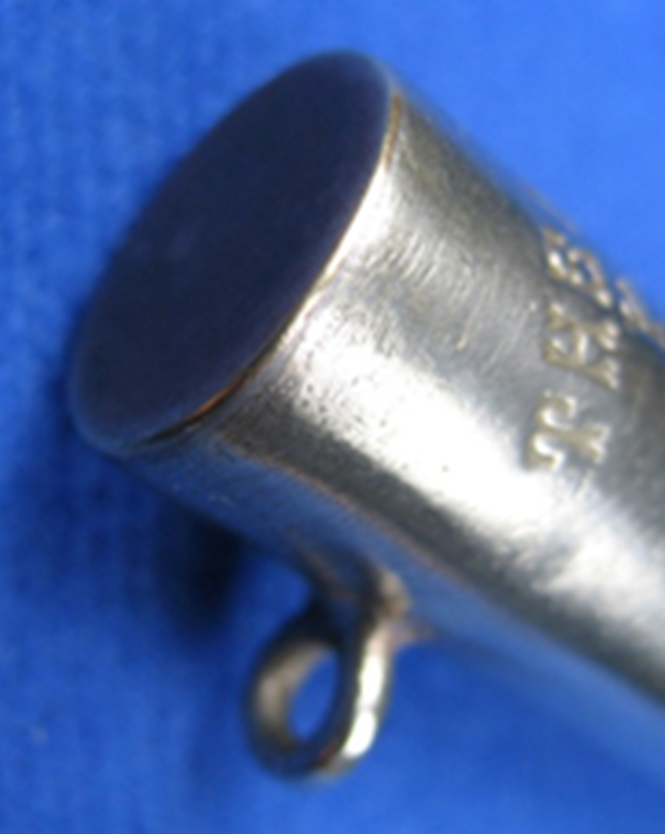
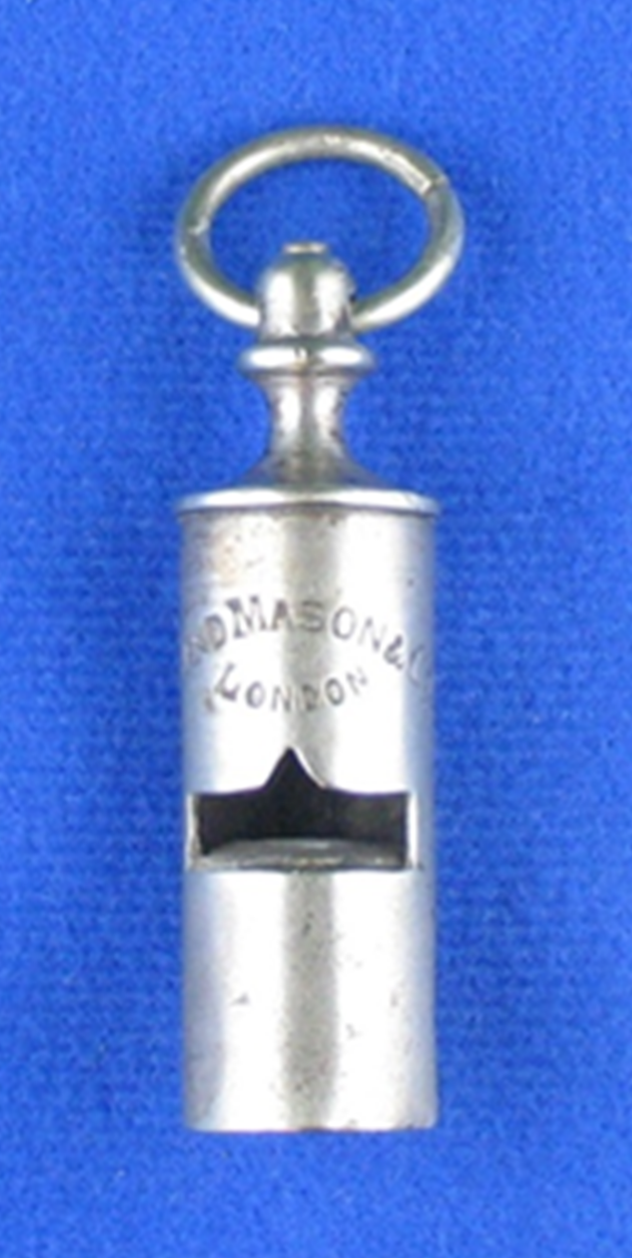
The following are Arthur Ward – police or fire
- The Standard Police or Fire, 90mm
- City Police or Fire Whistle, 80mm
- The City Police or Fire Whistle, 82mm
- City Police or Fire, 81mm
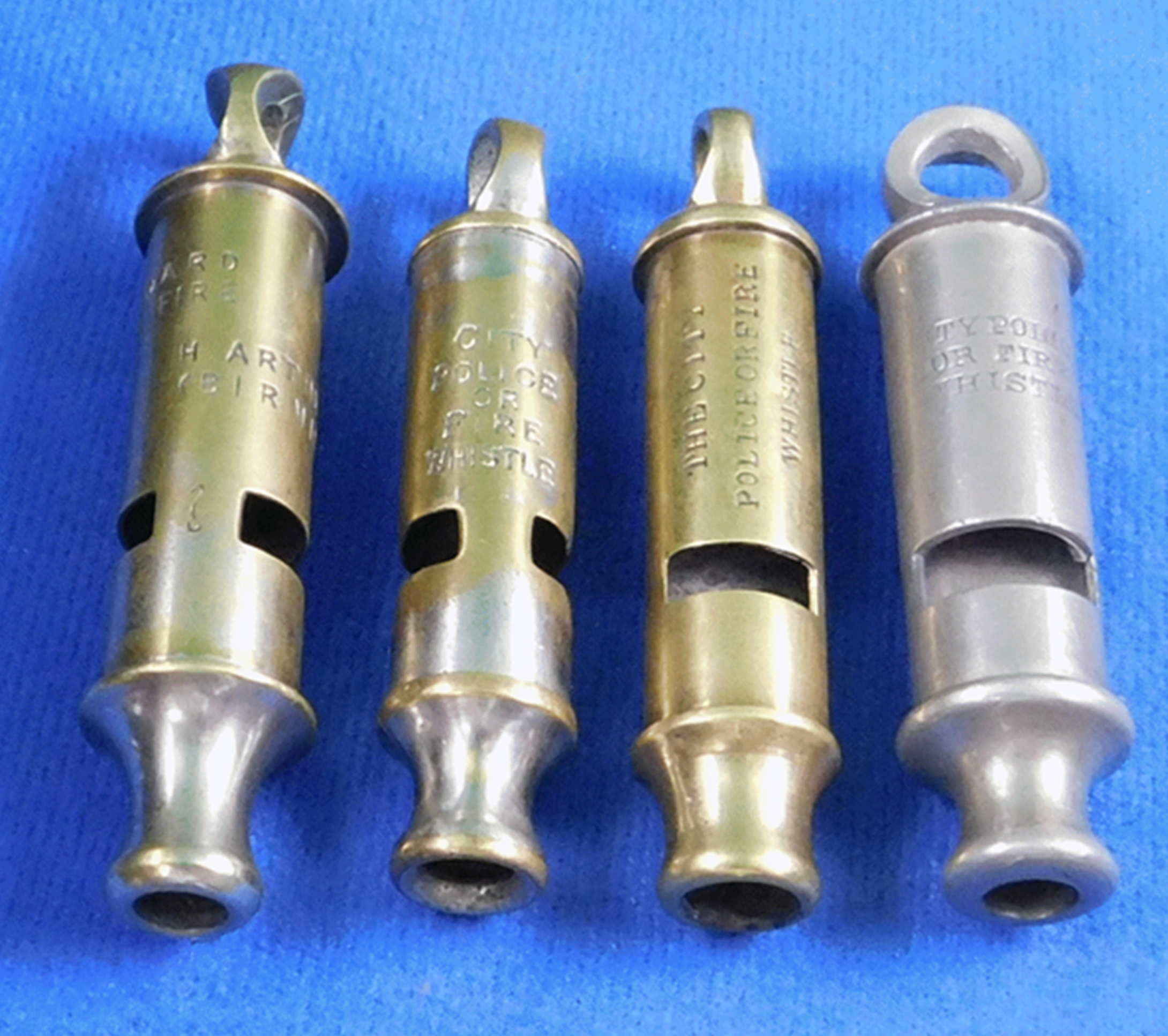
The following whistles are by Alfred DeCourcy:
- The City Police or Fire Whistle patent (17165)
- The City Police or Fire Whistle patent (17165)
- The City Police or Fire Whistle patent (3725)
- The City Police or Fire Whistle patent (3725)
- The City Police or Fire Whistle patent (3725)
- The City Police or Fire Whistle patent applied for (3725)
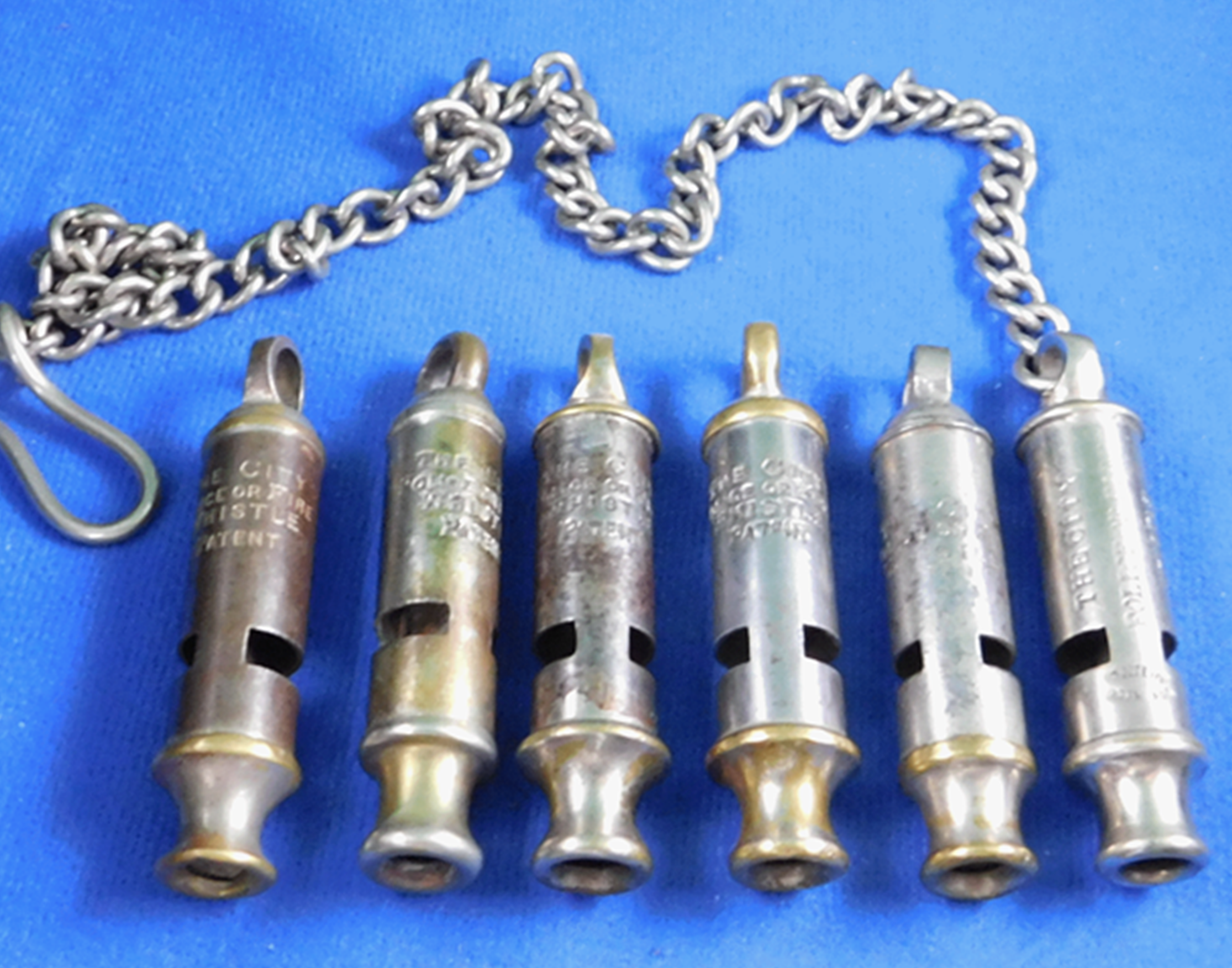
1.
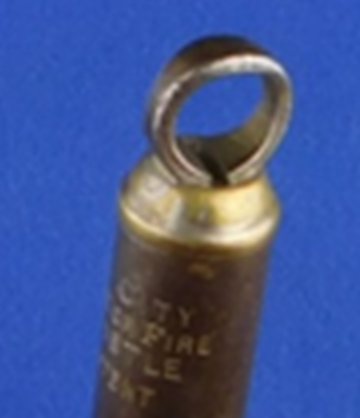
2.
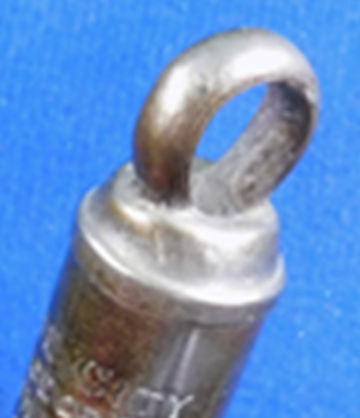
3.
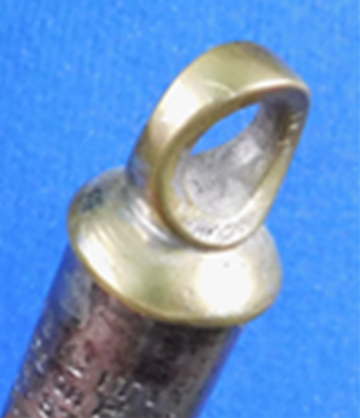
4.
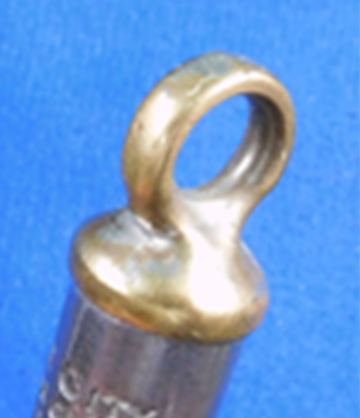
5.
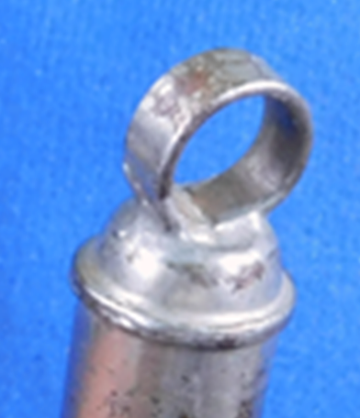
6.
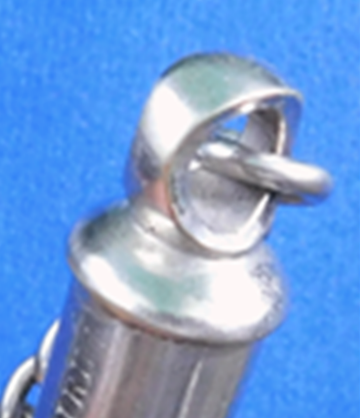
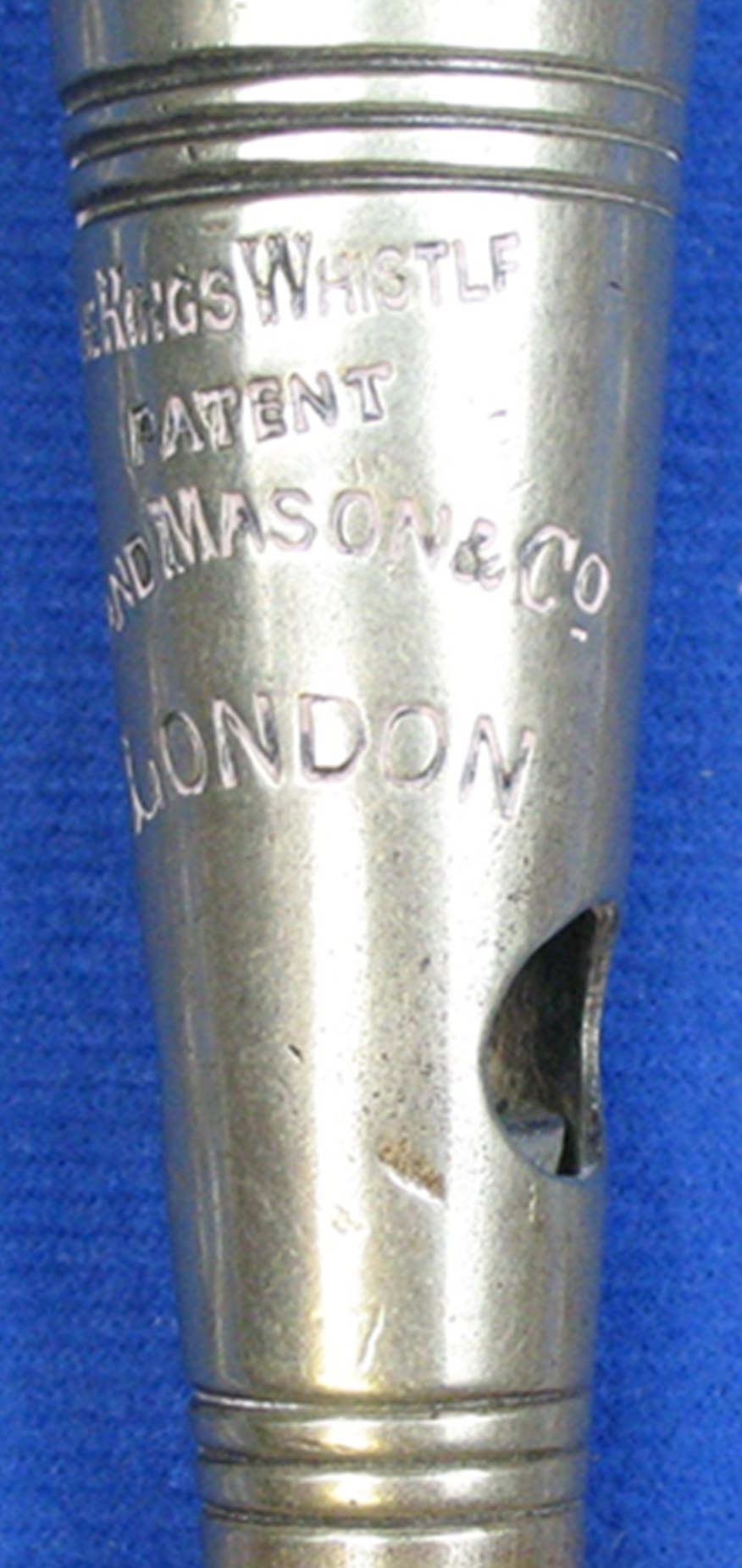
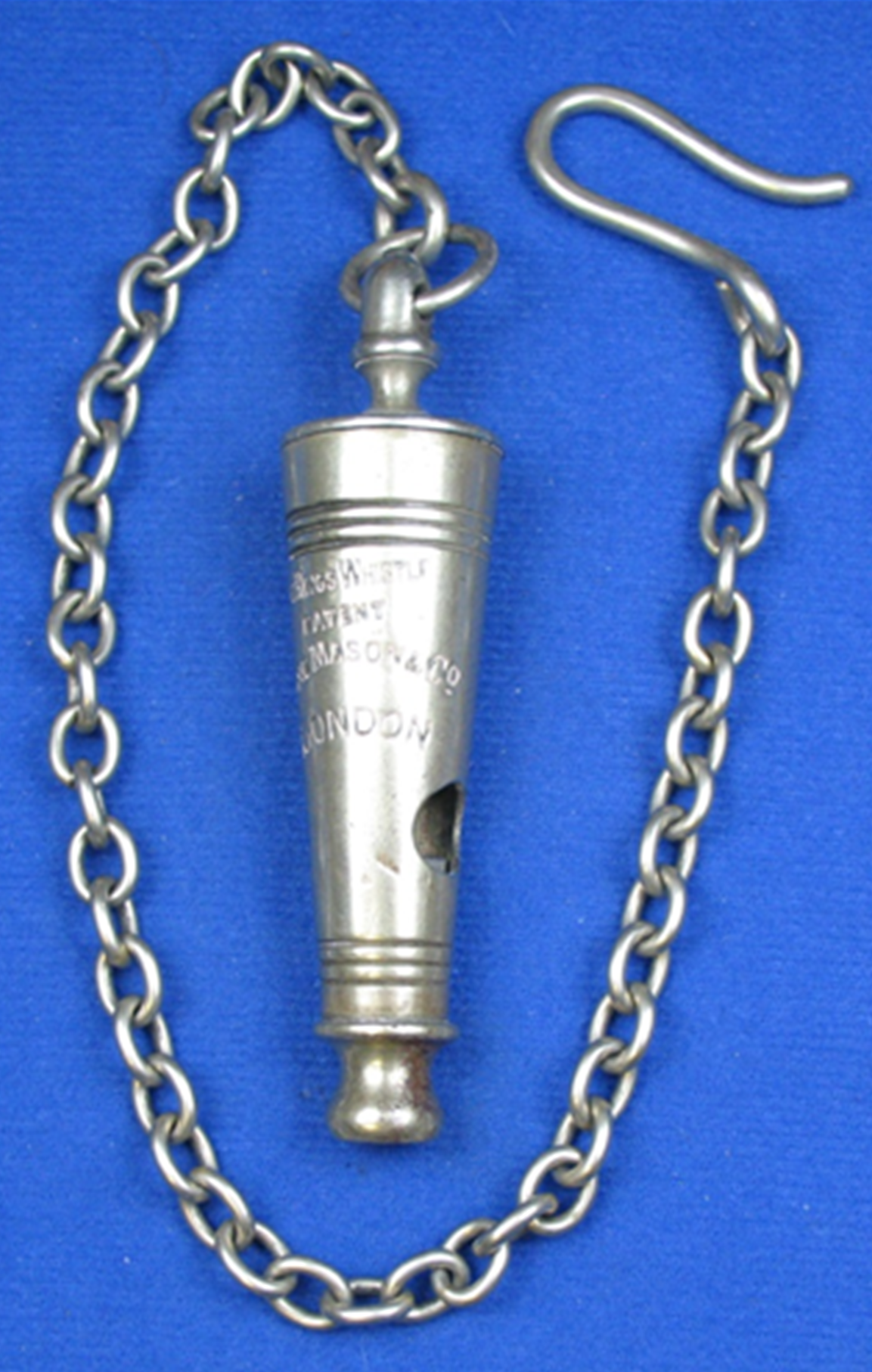

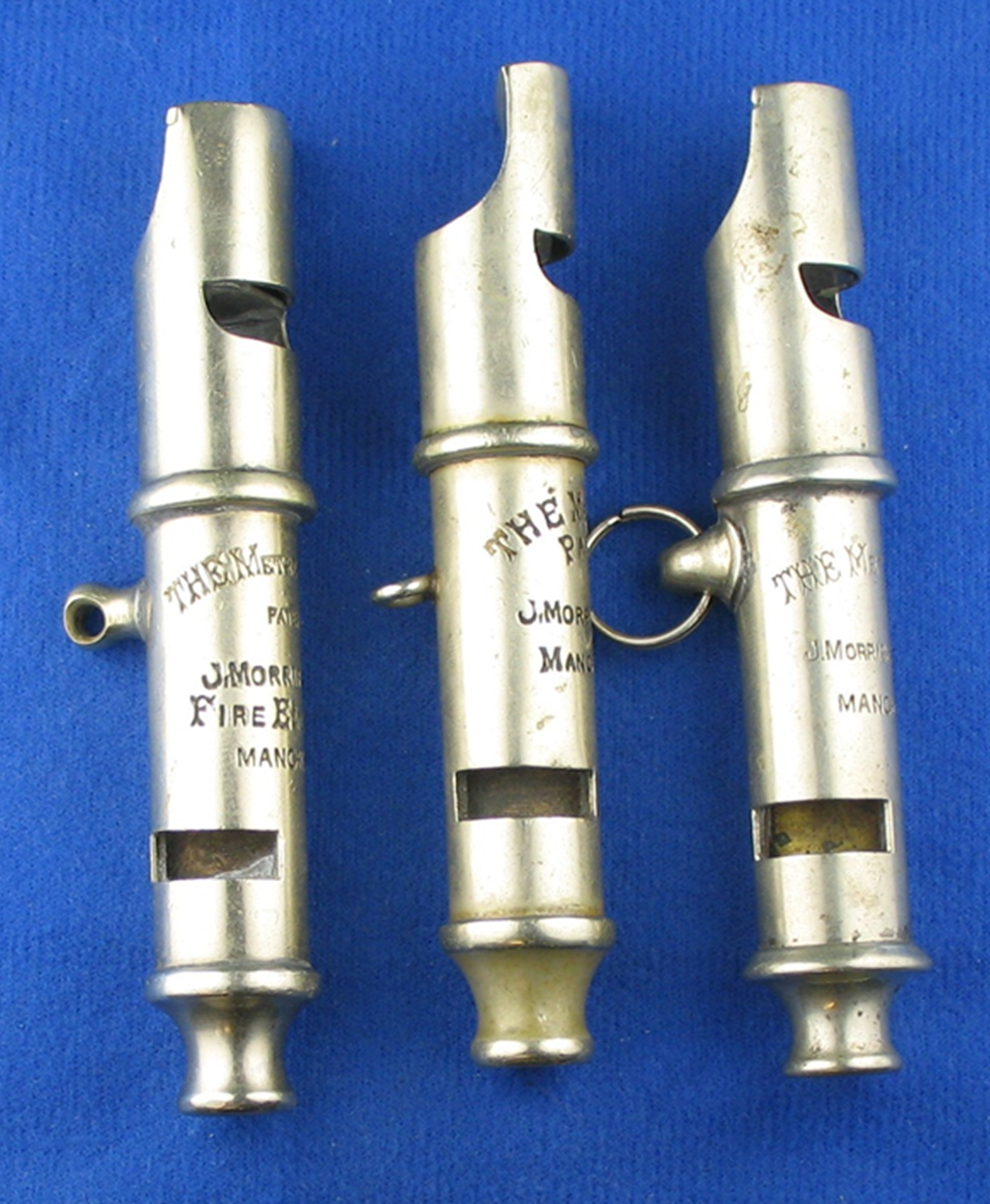
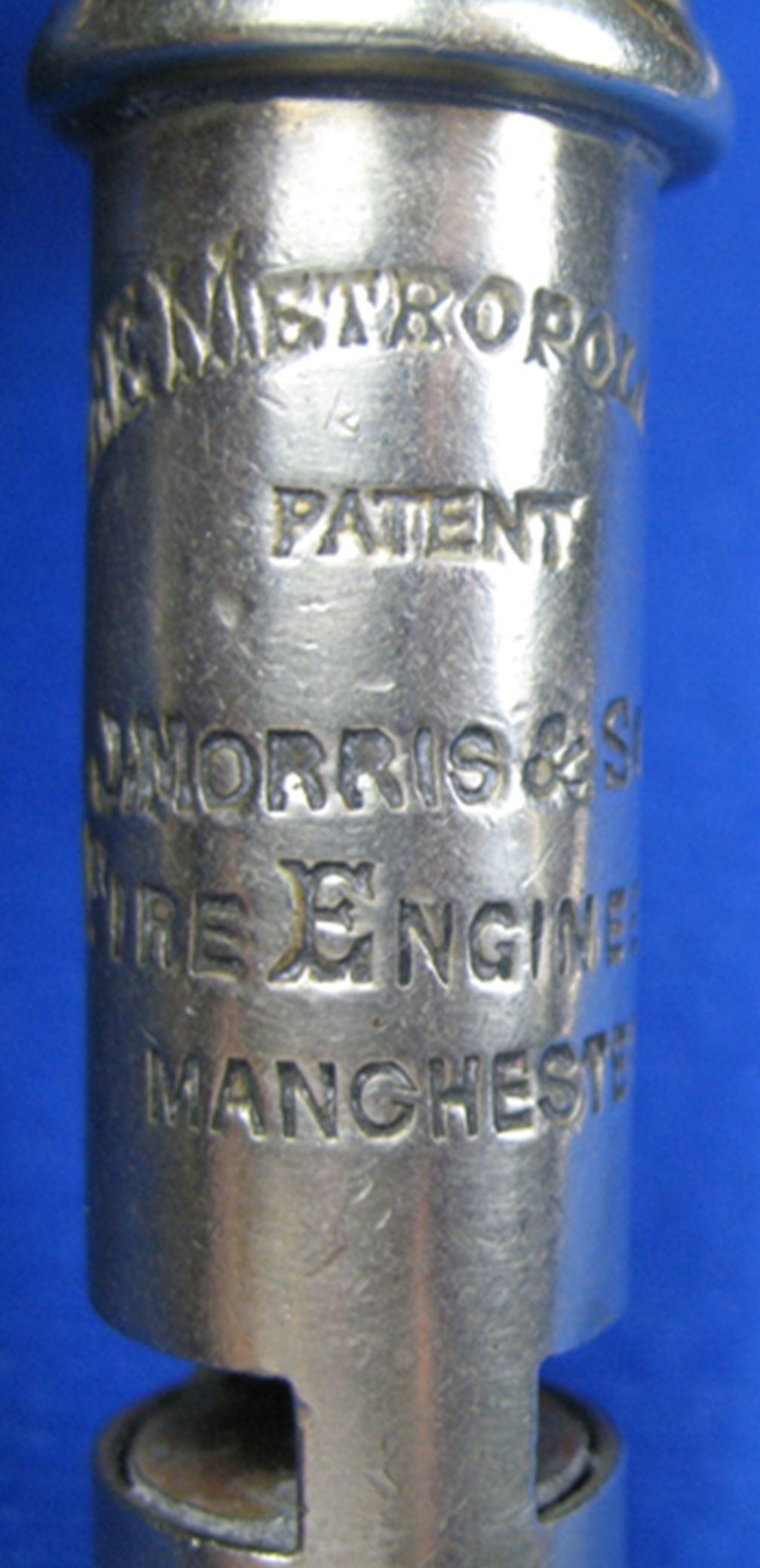
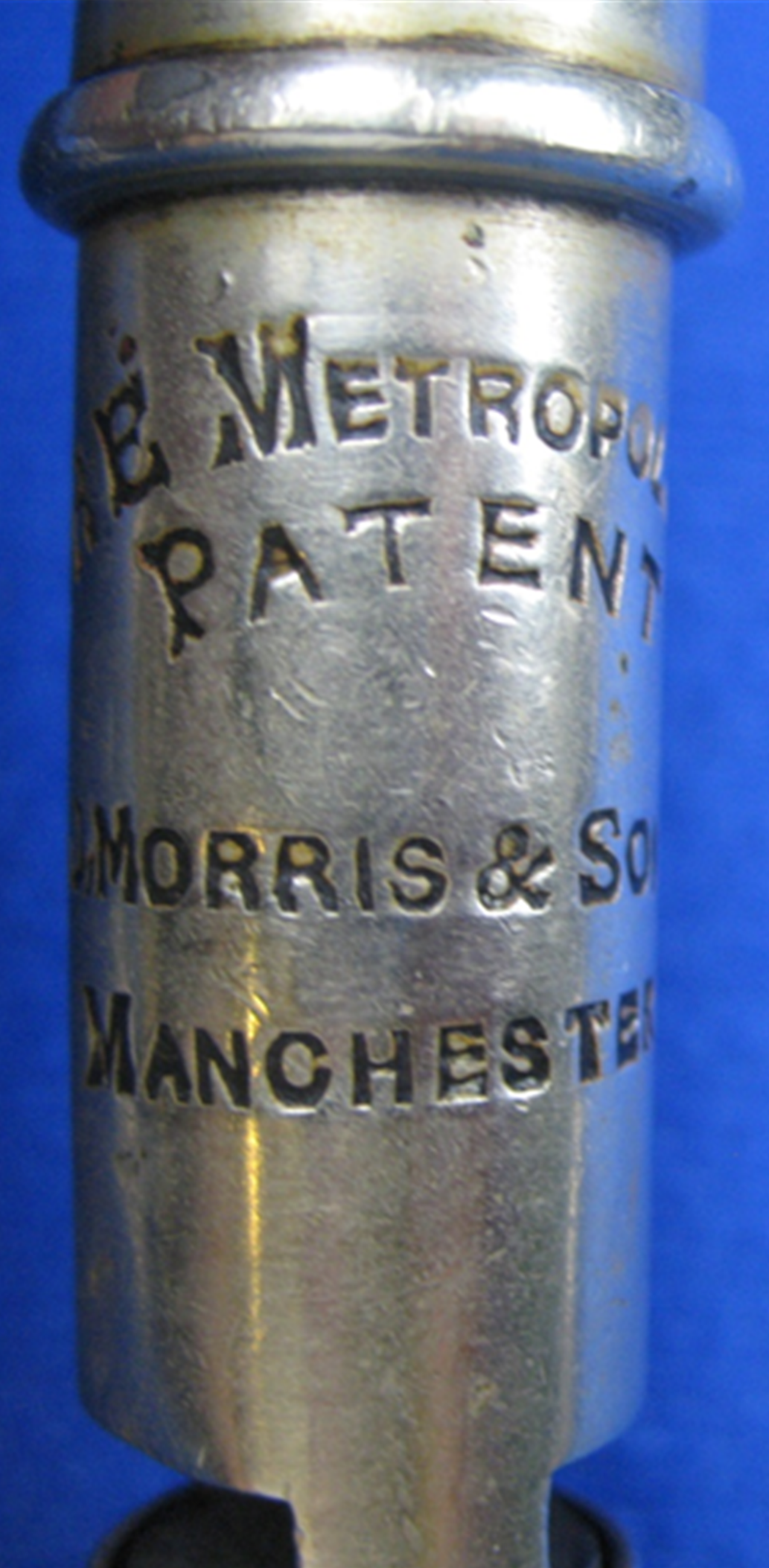
Beaufort from an unknown manufacturer, possibly Dowler.
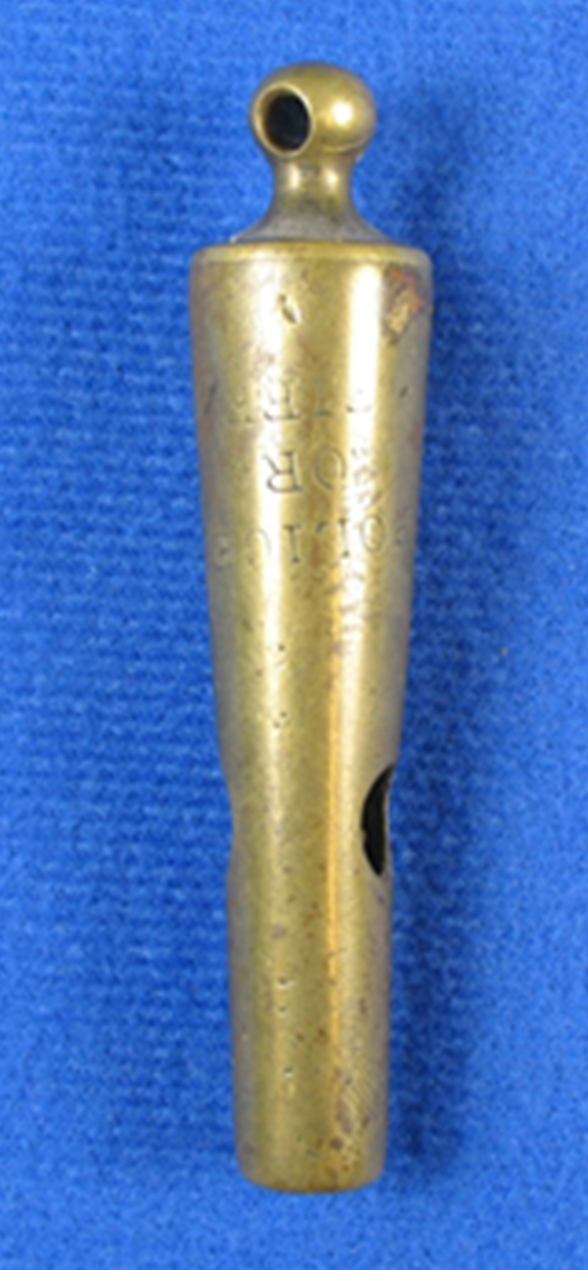
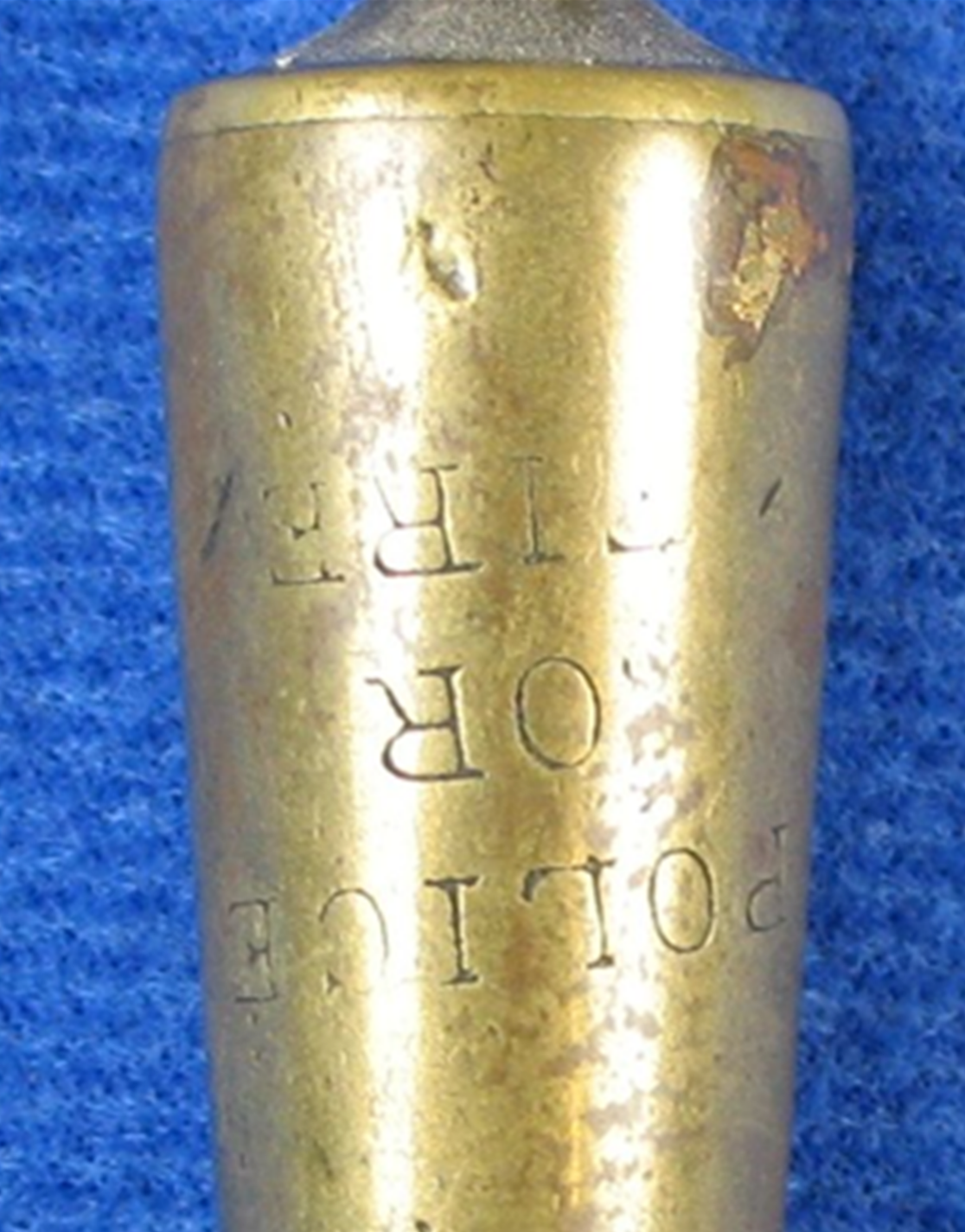
This combination possibly by Benjamin Lilly
(by permission from a private collection)
The Chief
LCC
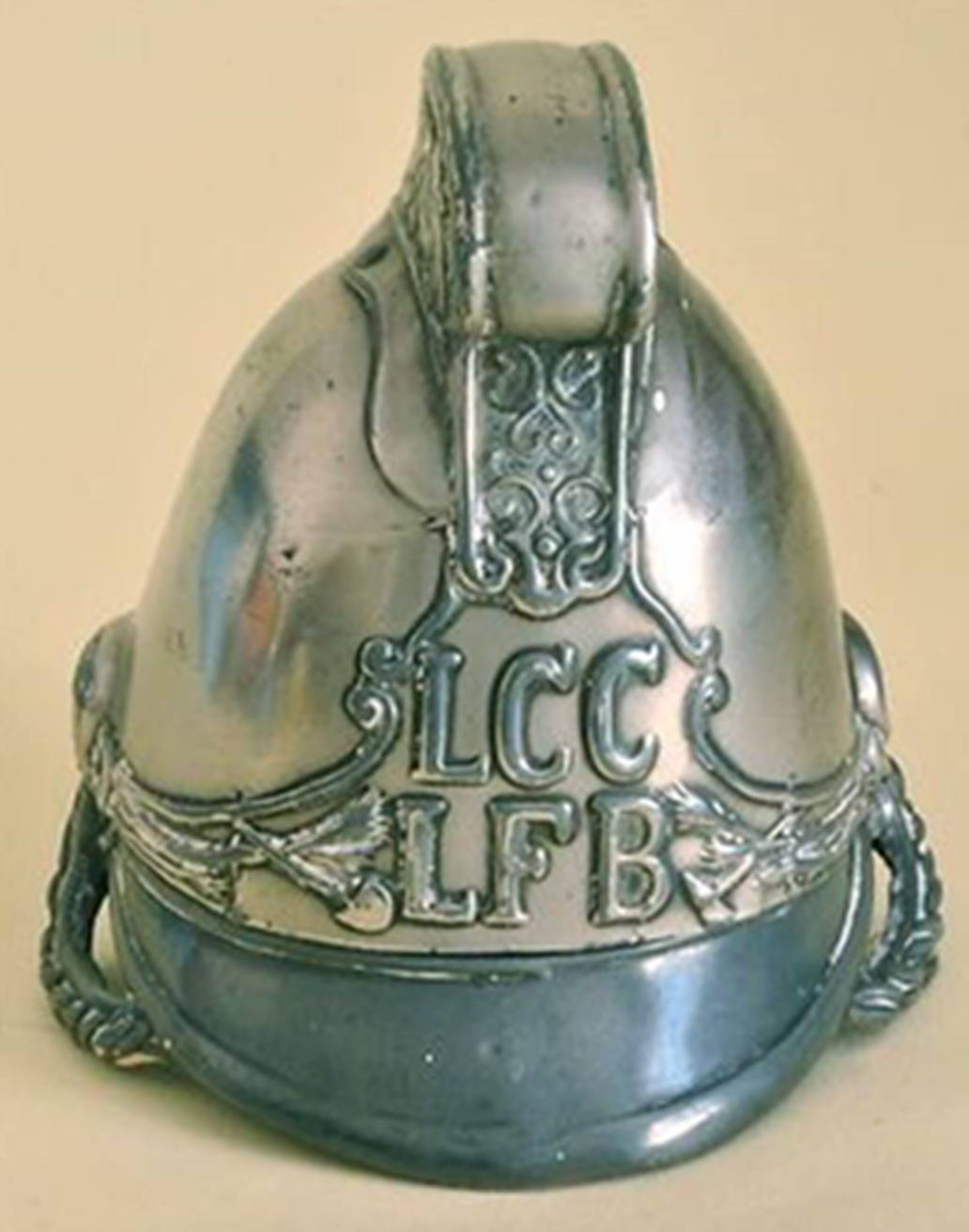
( Credit needed )
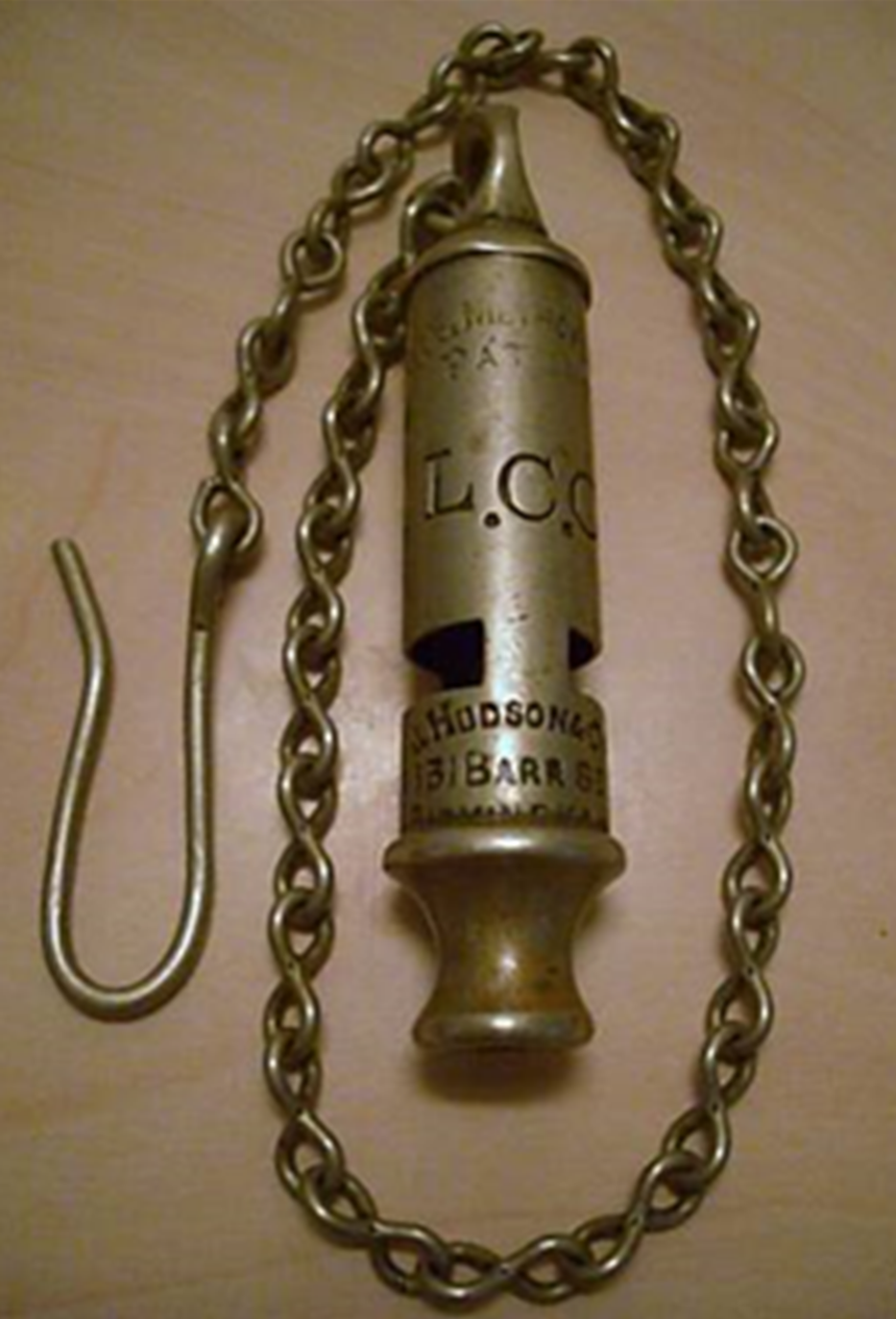
( Credit needed )
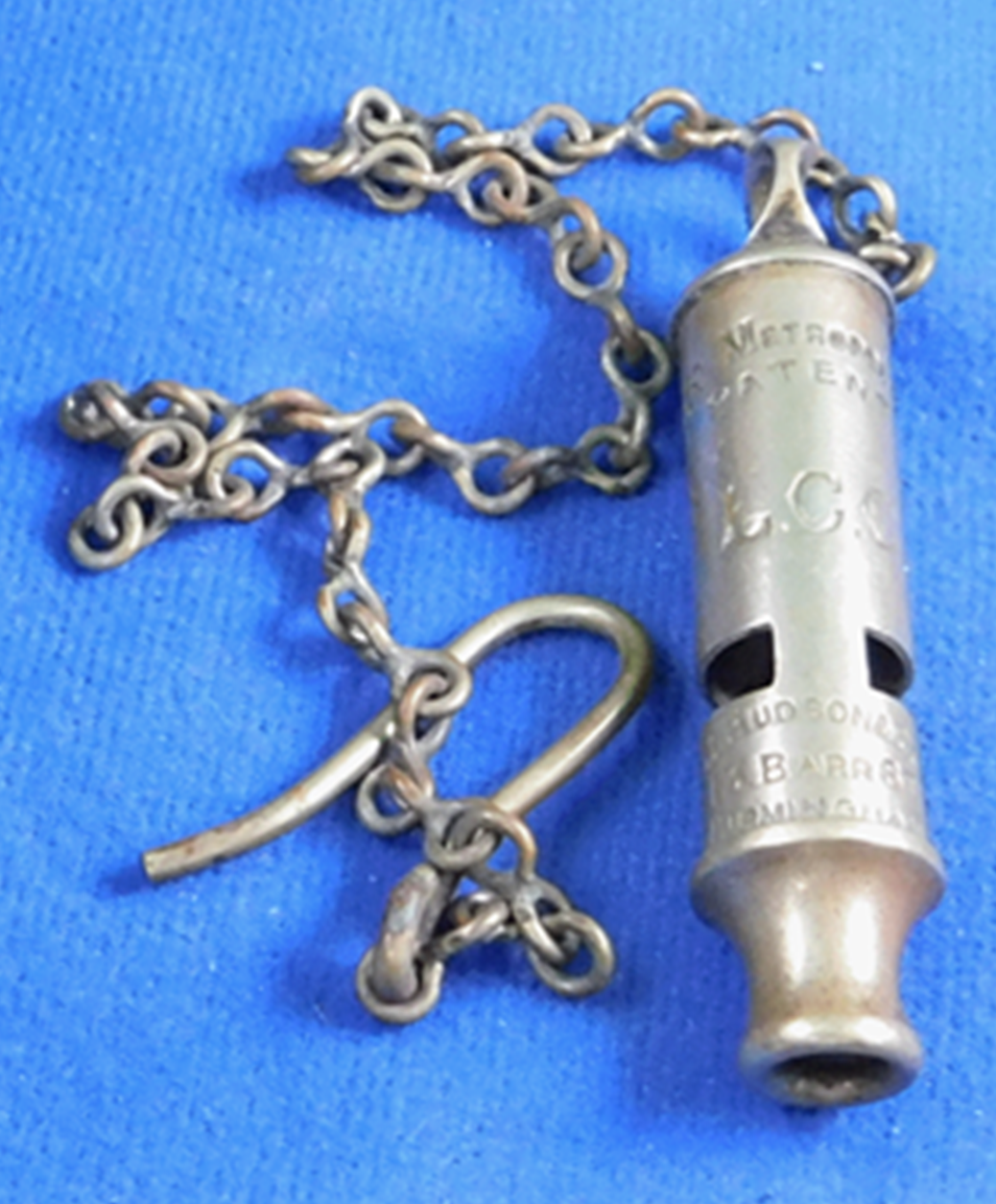
Engraved
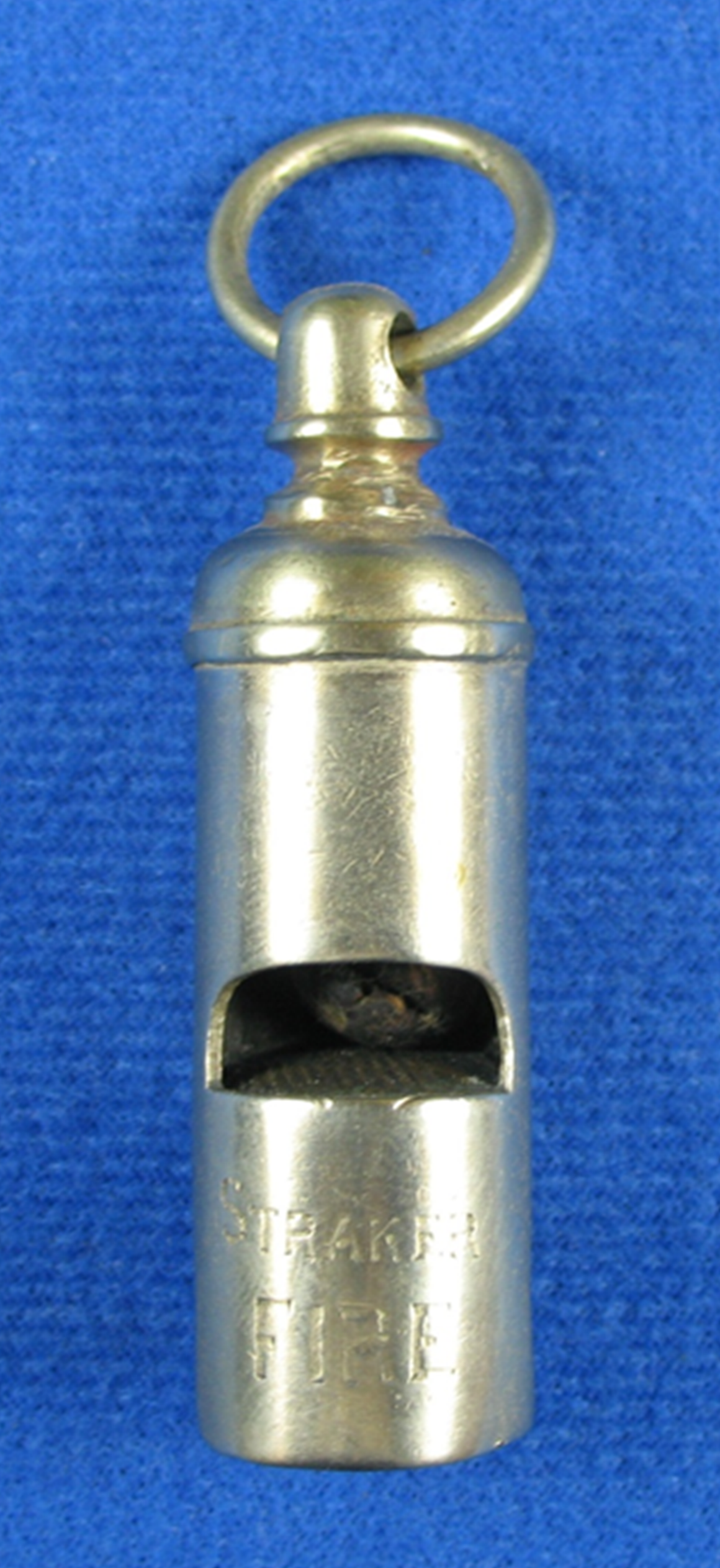
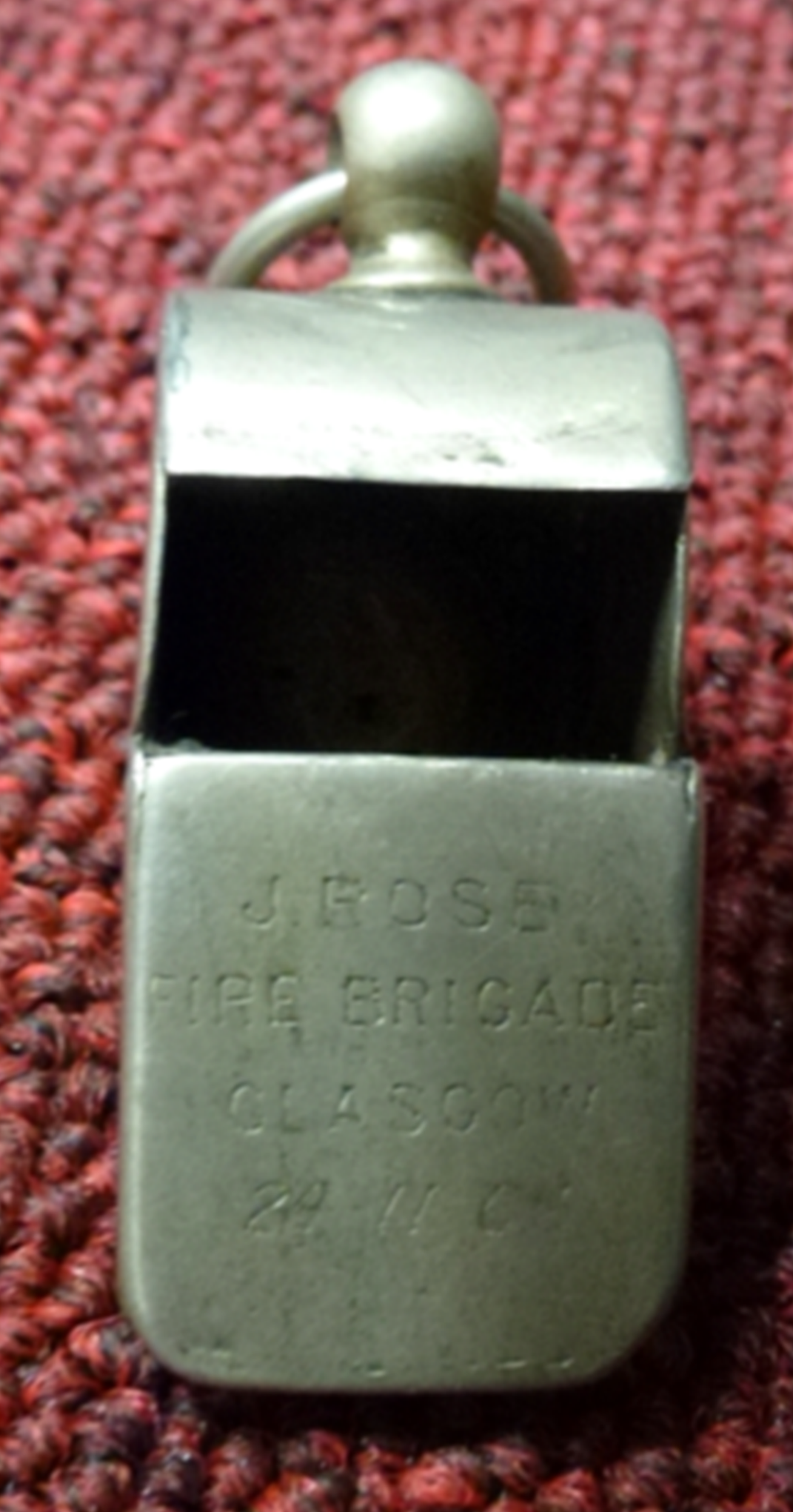
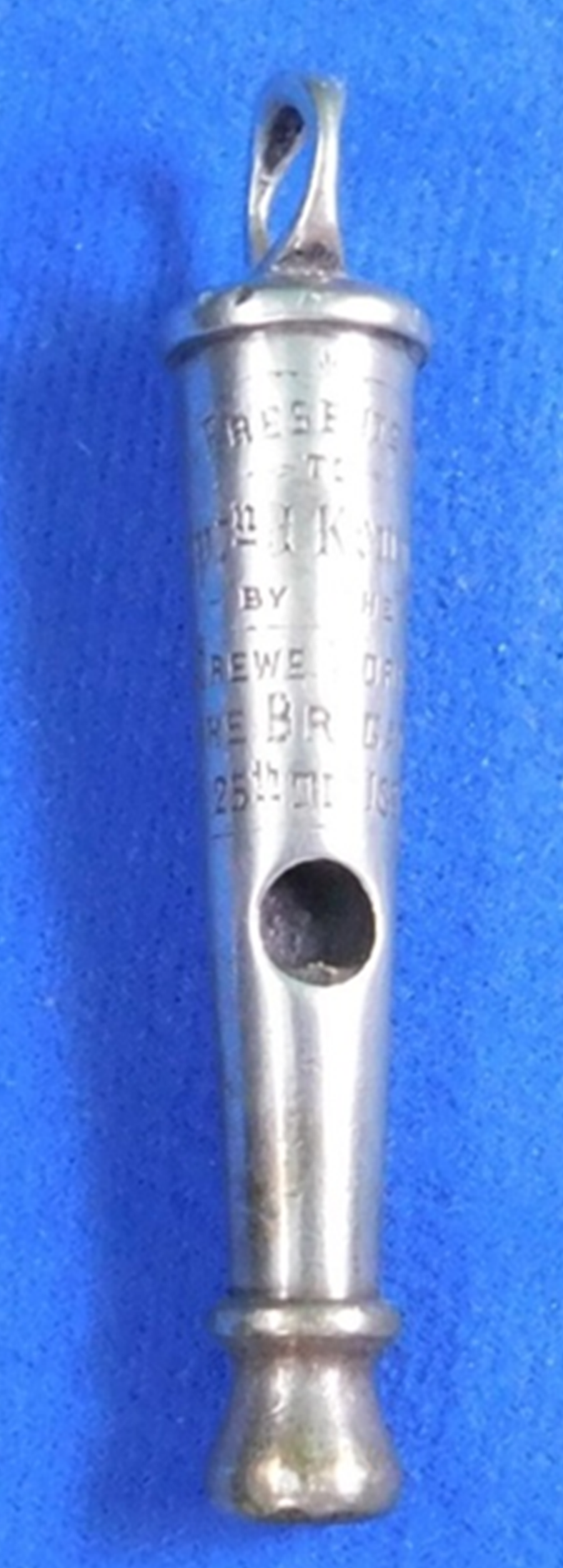
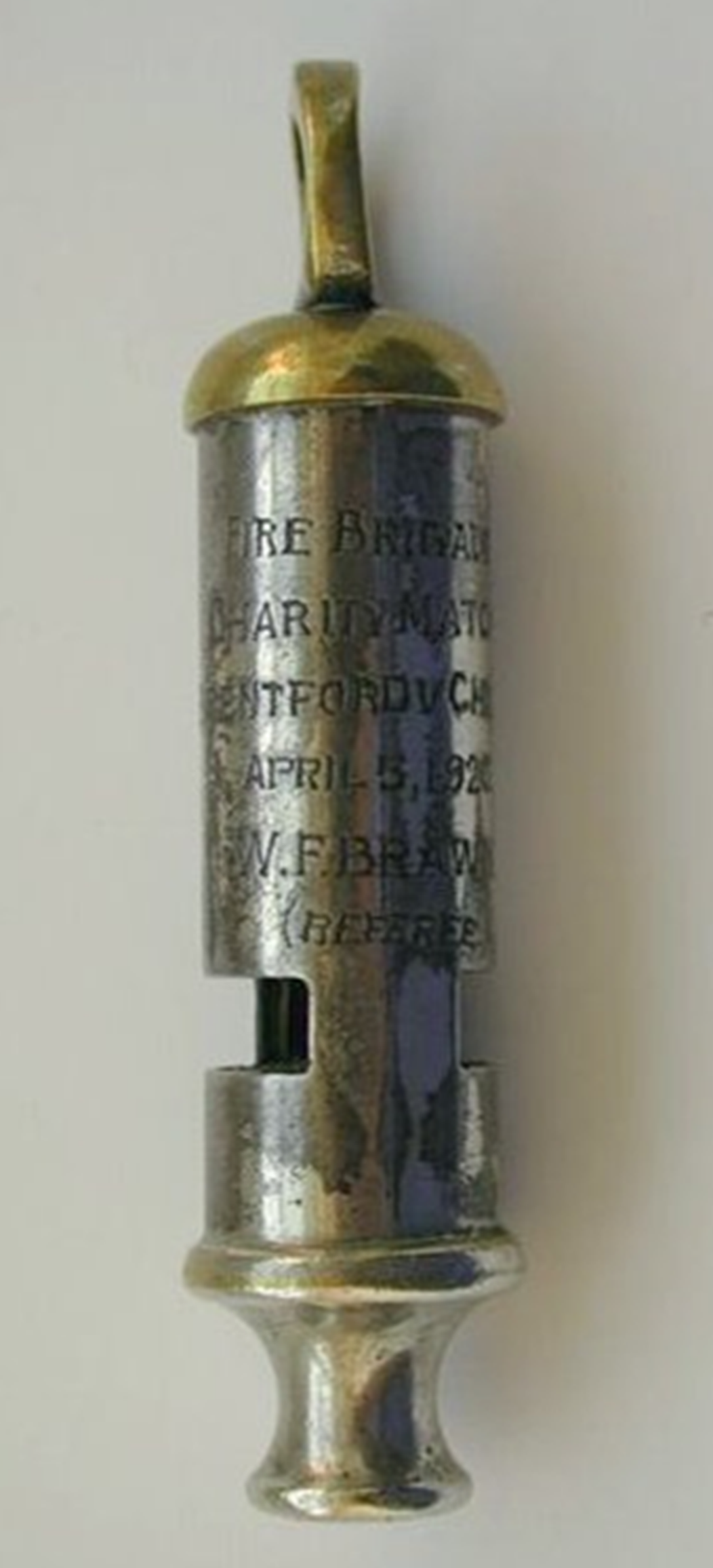
(credit needed)
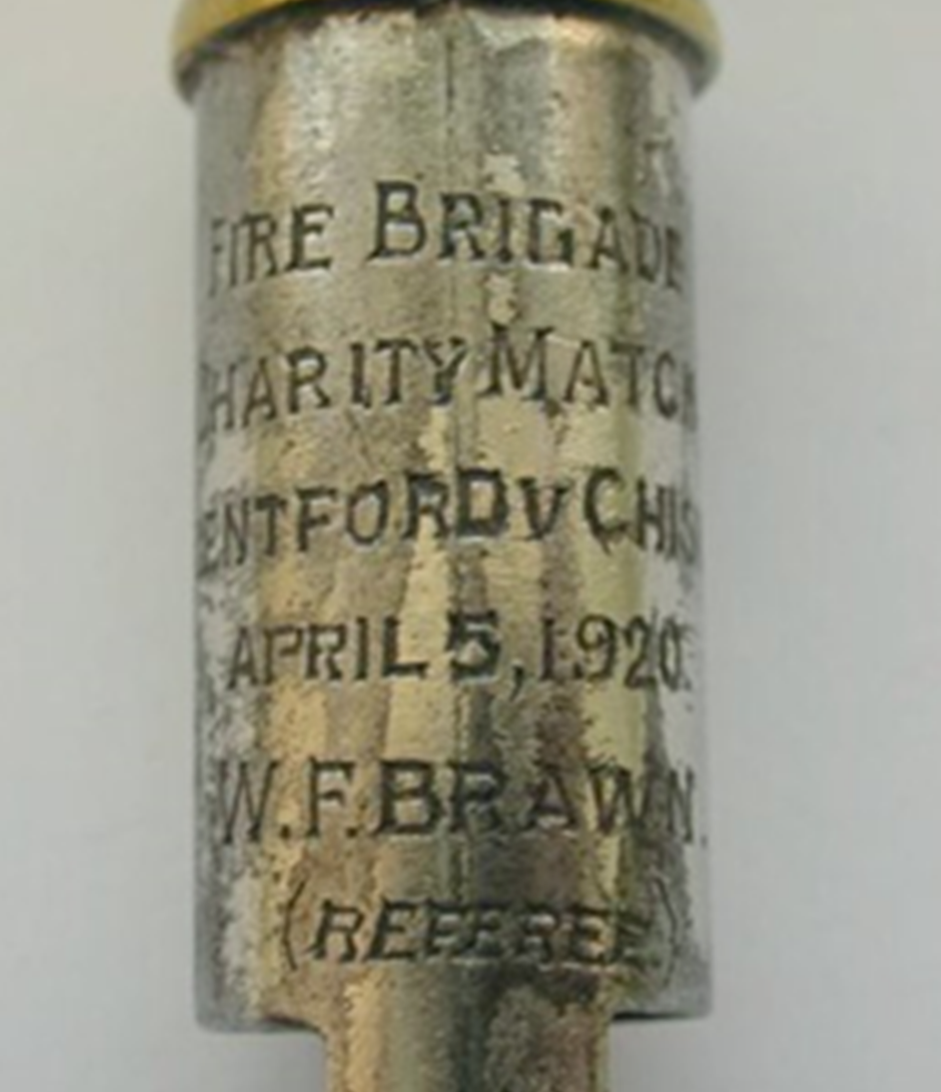
Provenance
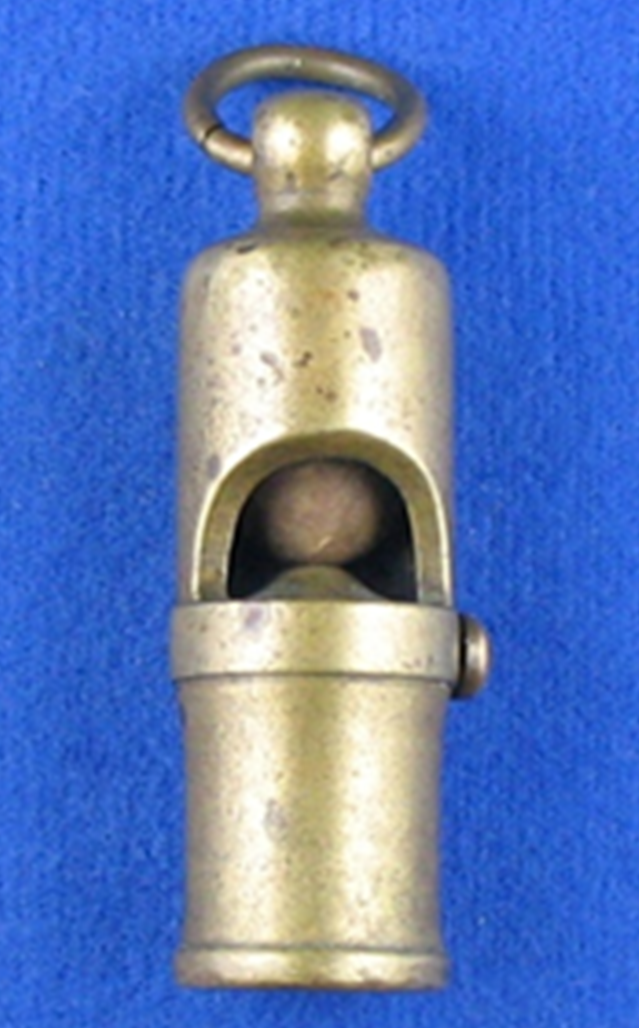
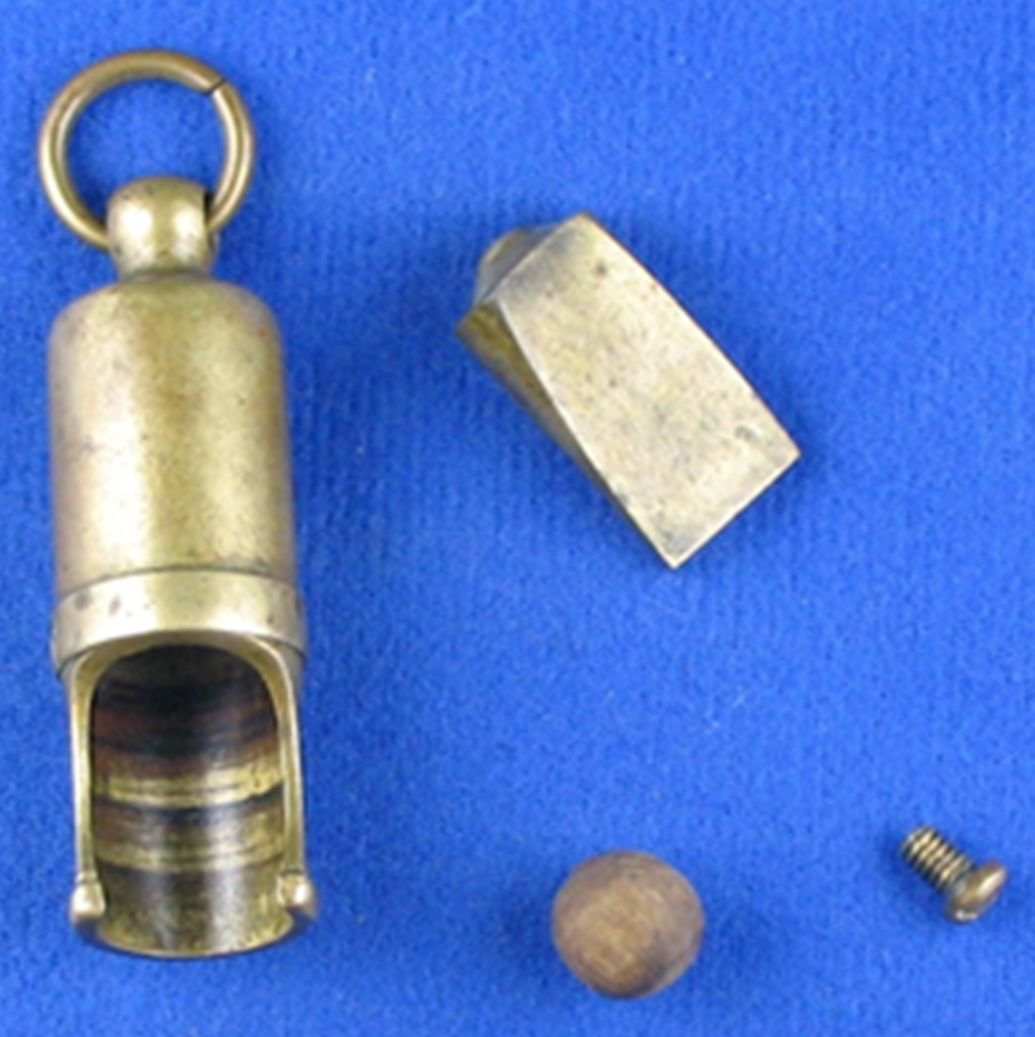
This remarkable round whistle came from Napa California. The historical society identified it from an estate of Charls Otterson the first fire chief.
A Samual Auld whistle with distributors stamp and provenance:
”These whistles were used by the constabulary and fire brigades throughout the city. The whistle was originally used by officers of the Govan Fire Brigade when it was an independent Borough who maintained their own Fire Brigades, it had two steam fire engines, escape ladders and hose carts.
The police station was situated next to the fire station, so who the original owner was is a mystery as they both used the same warning equipment…My family have been in the Glasgow fire brigade since the 1880s and particularly Govan and I was told by my grandfather whose father was a superintendent that they were given a lot of kit by the police as they were better funded than the brigade hence a police whistle ending up in the fire brigade they used it as a call to clear buildings on fire that were becoming to dangerous to fight from the inside…”
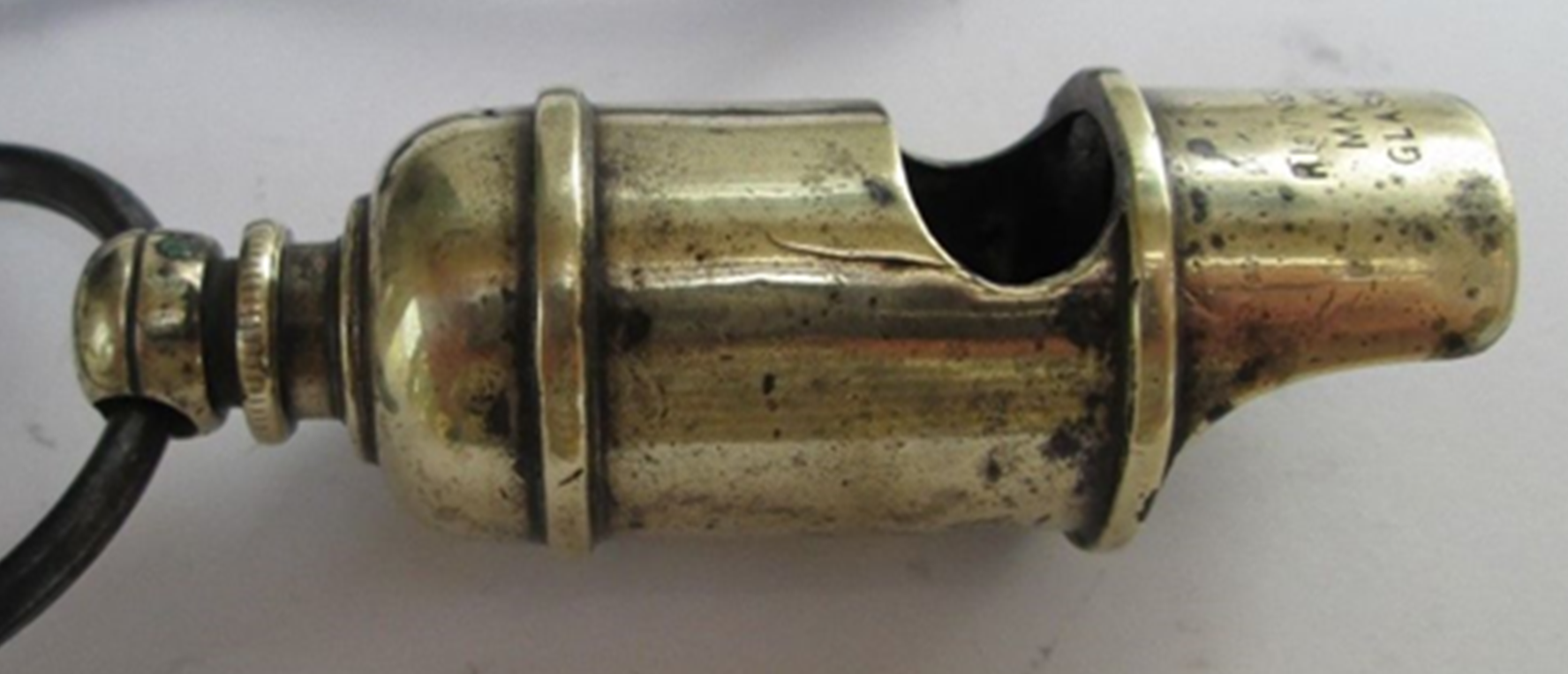
( by permission )
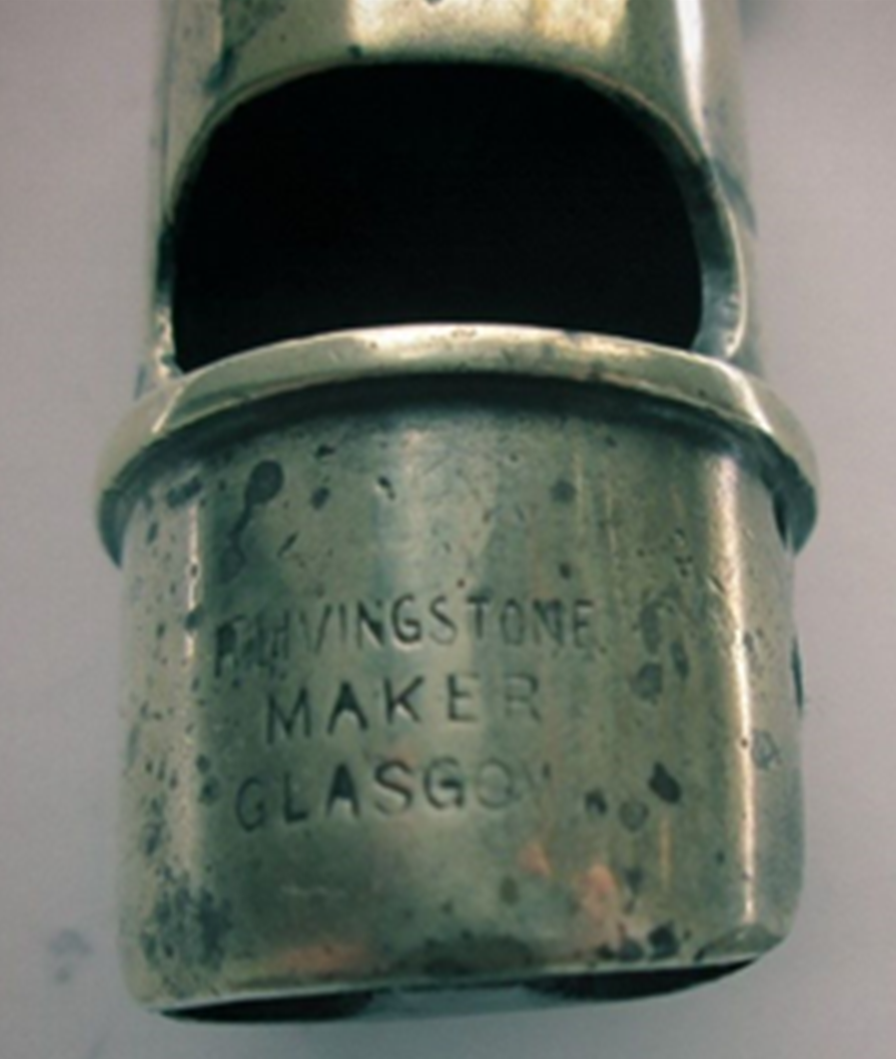
The following
catalog shows that any whistle can be used or even marketed as a fire brigade
whistle. The questions arises, does that make it so ??
Shand, Mason and Co., Illustrated Catalogue of Sundries and Equipments for Fire
brigade Use, page 28; Officers Whistles with Chains including Ivory Whistle;
Double Ended Whistle; Bell Whistle and Patent Leather Shoulder Belt with Wallet
( Science and Society picture library )
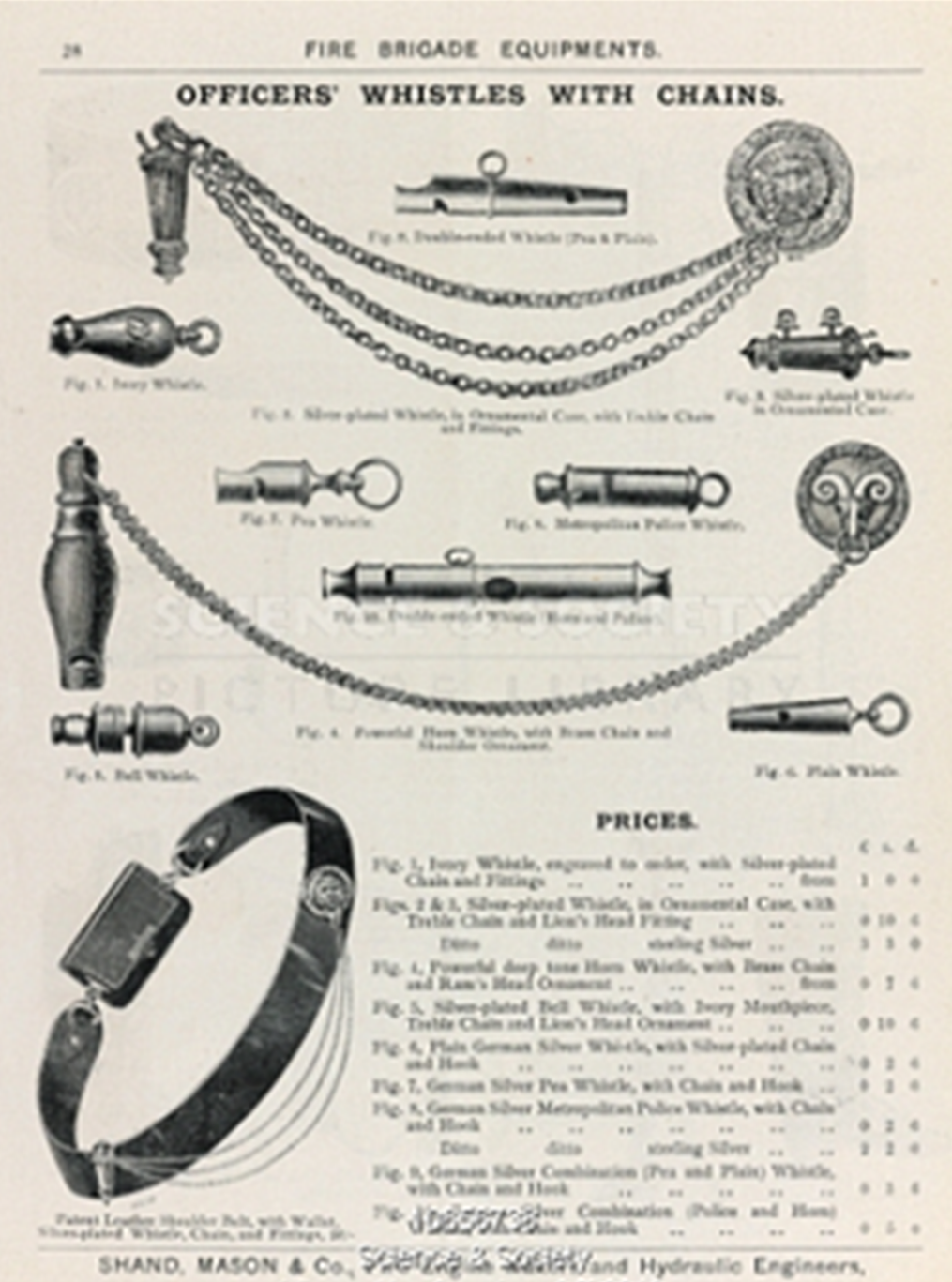
1) Ivory whistle engraved to order with silver plated chain and fittings
2-3) silver-plated whistle in ornamental case with treble chain and lion’s head fitting
4) Powerful deep tone horn whistle with brass chain and rams head ornament
5) Silver plated bell whistle with ivory mouthpiece with treble chain and lions head ornament
6) Plain German silver whistle with silver plated Chain and hook
7) German silver pea whistle with chain and hook
8) German silver Metropolitan Police whistle with chain and hook
9) German silver combination ( pea and plain ) whistle with chain and hook
10) ….. silver combination ( police and horn )…. Chain and hook
Bibliography:
- http://www.massillonohio.com/public-safety/police-department/the-history-of-the-massillon-police-department/
- List of UK fire brigades and mergers – https://en.wikipedia.org/wiki/History_of_fire_brigades_in_the_United_Kingdom
- http://www.firefighterfoundation.org.uk/history/
- https://www.britannica.com/topic/police/The-history-of-policing-in-the-West
- Police Use of Force under International Law-By Stuart Casey-Maslen, Sean Connolly
- http://www.emergencymuseum.org.uk/history.html
- https://aim25.com/cgi-bin/vcdf/detail?coll_id=13052&inst_id=118
- https://www.parishregister.com/LicensedRiverThamesWatermenandLightermen.pdf
- http://www.firefighterfoundation.org.uk/history/history-of-fire-fighters-foundation/
- https://www.hkfsd.gov.hk/eng/index.html
- https://www.scienceandsociety.co.uk/results.asp?searchtxtkeys=shand,%20mason
TWG
Posted March 5, 2020
